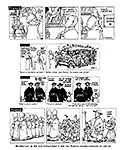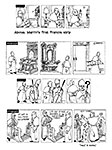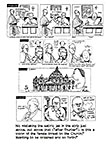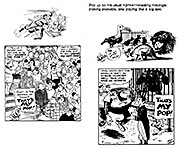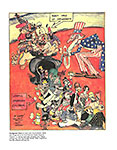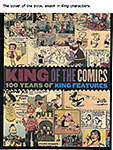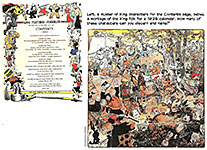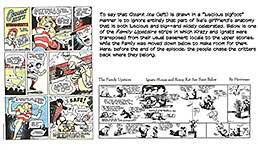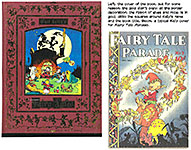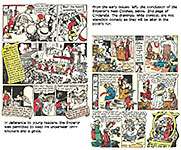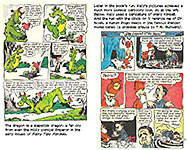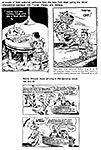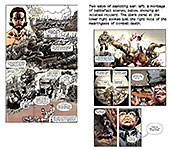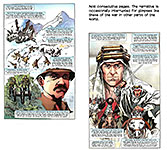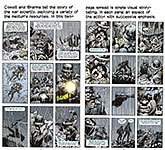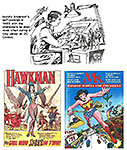 |
||||||||||||||||||||||||||||||
|
Opus 345 (October 30, 2015). This voluminous, copiously illustrated posting, open to all comers without entry fee or any other charge, includes these topics: Atena’s virginity test, Playmates denuded, a new but different comic-con, free speech over the last 10 years, Roy Crane defended, Jan Eliot retires Stone Soup, politics in strips, and the Pope Francis comic strip, plus reviews of comic books—Twilight Children, Mockingbird, Dr. Strange; and books— Mad’s Original Idiots, Milt Gross’ New York, Comics (A Global History), King of Comics, Walt Kelly’s Fairy Tale Parade, The War to End All Wars, and some of the best of last month’s editoons and obits for Murphy Anderson and Roger Bollen—and more, much more, all of which is listed immediately below. The purpose of the list (for those who’ve just joined us) is to make it easier for you to find what you might want to read about without having to wade through the whole magilla of topics you’re not interested in, one at a time. You don’t want to countenance my ranting about political issues under the heading of Editoonery (a review of some of the best editorial cartoons this month), fine; just skip over that when you’re scrolling through the posting. Does the 100th anniversary of King Features interest you? Fine, when you come to that book review as you scroll through this posting, stop and read. Are you a fan of Walt Kelly? Good, you can find a review of the latest compilation of Kellyworks, his Fairy Tale Parade, in the list; you’ll want to scroll down (quickly bypassing other topics) until you come to it. Want to see what the “new” Dr. Strange looks like? Excellent, just roll down the scroll until you come to that review under the heading Funnybook Fan Fare. Now, get started. Here’s what’s here, in order, by department, starting with the News Department (Nous R Us, get it?)—:
NOUS R US The Latest Assault on Decency in Iran Playmates To Put Their Clothes Back On How Opus Came Back New Comic-Con Is a Success in Columbus A Really Super Girl onTV
ODDS & ADDENDA Zunar Lecturing and Exhibiting in England Wimpy Kid on Tour New York Con Grows Graphic Novel Sales Have Biggest Year Graphic Novels on Banned Books List The Real Betty in Archie’s Adventures Peanuts Stamps for Christmas Denver Zombie Crawl
Free Speech Examined in the Wake of Danish Dozen: A Progress Report
PULP PROPAGANDA Jeet Heer Says Roy Crane Is a Propagandist (And I Have a Snit About It)
RANCID RAVES TRAVELOGUE Finding Abe Martin in Indiana
FUNNYBOOK FAN FARE Reviews of—: Twilight Children Mockingbird Paper Girls Beyond Belief Miracle Man Fred Hembeck Returns Dr. Strange Miami Vice Remix
EDITOONERY Some of the Month’s Best Editorial Cartoons
RANCID RAVES GALLERY Cartoony Visuals Taking Over
NEWSPAPER COMICS PAGE VIGIL Politics in Comics Only in the Comics Some Historic Moments
The Jan Eliot Story Retiring Stone Soup Creator Tells All
A Comic Strip Pope?
BOOK MARQUEE Book Reviews and Previews of—: Mad’s Original Idiots: Wally Wood, Jack Davis, Bill Elder Bill Griffith’s My Mother’s Love Affair Graphic Novel Peter Kuper’s Ruins The Multiversity Deluxe Edition
BOOK REVIEWS Milt Gross’ New York: A Lost Graphic Novel Comics: A Global History, 1968 to the Present King of Comics: 100 Years of King Features Walt Kelly’s Fairy Tales
LONG FOR PAGINATED CARTOON STRIPS (Graphic Novels) The War to End All Wars: World War One, 1914-1918 ONWARD, THE SPREADING PUNDITRY Some Things To Be Happy About
PASSIN’ THROUGH Murphy Anderson Roger Bollen Yogi Berra
QUOTE OF THE MONTH If Not of A Lifetime “Goddamn it, you’ve got to be kind.”—Kurt Vonnegut
Our Motto: It takes all kinds. Live and let live. Wear glasses if you need ’em. But it’s hard to live by this axiom in the Age of Tea Baggers, so we’ve added another motto:.
Seven days without comics makes one weak. (You can’t have too many mottos.)
And our customary reminder: don’t forget to activate the “Bathroom Button” by clicking on the “print friendly version” so you can print off a copy of just this installment for reading later, at your leisure while enthroned. Without further adieu, then, here we go—:
NOUS R US Some of All the News That Gives Us Fits
THE LATEST ASSAULT ON DECENCY Iranian Cartoonist Tested for Virginity By Comic Book Legal Defense Fund’s Maren Williams Iranian cartoonist Atena Farghadani, currently serving a nearly 13-year prison sentence for caricaturing members of parliament as animals, last week faced trial on the further charge of “non-adultery illegitimate relations” for shaking the hand of her lawyer, Mohammad Moghimi. Moreover, Amnesty International recently learned that Farghadani was forced to undergo virginity and pregnancy tests in August, purportedly as part of the investigation. Contact between unrelated members of the opposite sex is technically illegal in Iran, but rarely prosecuted. Moghimi is also charged, and both parties could receive sentences of up to 99 lashes if convicted. In a note leaked from prison, Farghadani said that she was taken to a medical center on August 12 and subjected to a virginity test against her will. Such tests are carried out by physically checking for the presence of a hymen, and are recognized by the World Health Organization as a form of sexual violence. In addition to the assault, Farghadani also reports that she has been the target of “lewd gestures, sexual slurs and other insults” from prison guards and officials since the “illegitimate relations” charge was introduced in June. Farghadani was first arrested last August (2014) for her cartoon mocking members of parliament as they debated a bill to ban voluntary sterilization procedures such as vasectomies and tubal ligations in an effort to reverse Iran’s falling birthrate. But even before her arrest, she was already well-known to the government for her fearless advocacy on behalf of political prisoners, Baha’i minorities, and the families of protesters killed after the country’s presidential election in 2009. When Farghadani was released on bail while awaiting trial, she promptly uploaded a video to YouTube detailing abuses she suffered in prison including beatings, strip searches, and non-stop interrogations. She was rearrested in January and finally received the draconian sentence after a perfunctory jury-less trial in late May. Last month, she was honored with the 2015 Courage in Editorial Cartooning Award from Cartoonists Rights Network International. A judge is expected to rule on the “illegitimate relations” charges against both Farghadani and Moghimi this week.
PLAYMATES TO PUT THEIR CLOTHES BACK ON The big news of the month was the announcement that, starting with the March 2016 issue, Playboy will no longer publish photos of completely naked women. They’ll be somewhat undressed but not entirely. In plainer language, they’ll still be nearly naked. For the magazine that got famous by picturing naked women and then catapulted that fame into notoriety by neglecting to airbrush pubic hair out of the pictures, the announcement was a jolt just this side of volcanic. Even more shocking, 89-year-old Playboy founder/publisher Hugh Hefner, crusader for the sexual revolution in the 1950s, agreed to the nefarious plan to drop the full nudes. The Internet is the reason for this seeming descent into uncommon modesty according to Playboy CEO Scott Flanders, quoted by the Associated Press and others: “You’re now one click away from every sex act imaginable for free,” he said, “and so it’s just passe at this juncture.” But that seems suspicious to me. I think Larry Flynt, founder/publisher of a Playboy rival, Hustler, is closer to nailing the truth of the matter. (He denies, by the way, that Playboy is a competitor. “My only competitor is Gynecological Monthly,” he sniffed.) He thinks dropping nudes is a terrible mistake: “What made Playboy popular to begin with?” he asks, rhetorically. “It wasn’t the interviews. It wasn’t the editorial content. It was the centerfold. They’re taking out the main event. It just doesn’t make sense.” Flanders says Playboy’s new approach with more serious articles aims at more affluent young men. “That’s the wrong approach,” said Flynt. “You have to have broad demographic appeal if you’re going to publish a magazine. They don’t have the truck drivers. They have the college professors. They’re narrowing their demographic. You need a broad demographic to get a maximum circulation. “I think they’re losing money, and [the new nudeless approach] is a sign of desperation,” he continued, as reported at money.cnn.com. “There were a lot of advertisers that Playboy could never get because they had nudity. They take the nudity out, and they think they’re going to get more advertisers. But you take the nudity out, you lose the demographic and you can’t get advertisers [without that demographic]. So it’s a bad business decision.” Playboy has been in trouble for some time. It’s circulation, 5.6 million at its height in 1976, has dropped to about 800,000, reported Reuters. Page count has steadily eroded over the last dozen years, standing, today, at about 126 pages per issue. According to Megan McArdle at Bloomberg View, “Playboy’s American print magazine now loses millions of dollars a year, and is essentially a loss-leader for the Playboy brand, which is licensed hither and thither across the globe.” The competition for Playboy is no longer Playboy imitators (Dude, Gent, Jem, Penthouse), few of which remain. The competition is the laddie magazines—Maxim, King, FHM, Gear, Stuff, Open Your Eyes, etc. And Playboy has attempted to meet the competition by revamping its opening pages: they are now sprinkled with short, paragraph-long articles and squibs of information, snatches of statistics, and graphics—just like the laddie mags. These adjustments apparently haven’t revived the magazine’s circulation. So the editors plan a major overhaul, beginning with the March 2016 issue. Bulkier, heavier paper to make it seem more magazine than it is. And more in-depth articles. In
the midst of so much more, there will be a conspicuous less. Less female skin.
Still sexy, though, they vow. By way of demonstrating how sexy a nearly naked
woman can look, here are a few pictures clipped from the magazine (including a
recent cover!), plus the latest advertisement for the Playboy calendar
(which, the ad notes, will “include full nudity’). So
the denuding at Playboy has already started. It makes me wonder, though,
whether the same dictum will apply to cartoons in which young female embonpoint
has usually been a visual factor. Dean Yeagle, f’instance, is an expert
at it (as we can plainly tell in the adjacent visual aid). The move to clothe erstwhile nudes began with a suggestion from top editor Cory Jones. “Don’t get me wrong,” he protested, “—the twelve-year-old me is very disappointed in the current me. But it’s the right thing to do.” The “right thing”? What’s right about it? Playboy dropped full nudity at its website in August 2014. And visits increased from about 4,000 to about 16,000. With that statistic as harbinger, the next step was clear to Jones and to the other bean-counters at Playboy: do away with nudity. Whether this move will result in discontinuing the iconic centerfold is not, at the moment, known. At least, not known by me. Clearly, barenekkidwimmin are no longer as hot as they once were. If sex is the next thing to go out of fashion, there’ll soon be no readers for Playboy. Or for any other magazine. While I fear for the continuation of the human species, I fear more for the fate of cartooning. Playboy is one of the two remaining regular venues for single-panel gag cartooning in the U.S. (the other being The New Yorker). And if Hefner’s magazine is going for more articles—more text—in an effort to be a more serious, adult publication, then it wouldn’t surprise me to learn that cartoons will be discarded in the rush to adultery—er, adulthood and other grown-up notions and nostrums. The retreat from full nakedness has already set in, but I was still alarmed—shattered, really—by the magazine’s November issue, which just arrived. Full-page color cartoons were present in their usual abundance, but in the back of the magazine, there were no smaller cartoons, typically numbering 9-12 per issue. In November, none. Nada. Zero. After the magazine’s successful campaign to advance civilization by making sex acceptable in mixed company, it is discouraging in the extreme to think of that same crusading publication deliberately impoverishing civilization by eliminating the visual impulse to laughter about sex. A sad day indeed. But I’m just imagining the worst. Perhaps sanity, what little of it remains after turning away from completely naked women, will prevail at Playboy. Perhaps cartoons will endure—or make a comeback. I am encouraged by the recollection that Hef is an avid cartoon advocate (a frustrated cartoonist himself). Don’t give up hope just yet. Don’t give up hope for barenekkidwimmin either. As one Twitter wit noted: “I expect Trump to release a statement today that when he’s president, he’ll put the nudes back in Playboy and make the Playmates pay for it.”
HOW OPUS CAME BACK Interviewed on NPR’s “Fresh Air” about the reincarnation of Bloom County on Facebook, cartoonist Berkeley Breathed talked about why he brought back Opus and Company: “I watched slack-jawed in horror as they threw one of the 20th century's most iconic fictional heroes, Atticus Finch, under the bus. At the time—and this was a couple of months ago—it made me think that there would have been no Bloom County without Mockingbird because I was twelve I read it, and the book's fictional Southern small town of Maycomb had settled deep into my graphic imagination and informed it forever. If you look at any of my art for the past 30 years, there's always a small-town flavor to it. “So this summer,” Breathed went on, “just a couple months ago when Go Set A Watchman [Harper Lee’s “prequel” to To Kill a Mockingbird] was causing an uproar, I went back to my files and I pulled an old fan letter from years ago. It says (reading): ‘Dear Mr. Breathed, this is a plea from a dotty old lady and from others not dotty at all. Please don't shut down Opus. Can't you at least give him a reprieve? Opus is simply the best comic strip there is and depriving him of life is murder— a hard word to describe an obliteration of your creation. But Opus is real. He lives. Harper Lee, Monroeville, Ala.’ “When I pulled that out,” Breathed continued, “— I hadn't seen it for 25 years. And I choked up, and I thought about the preposterously ironic impossibility of my literary heroine from my childhood demanding that I not kill one of her fictional heroes. The universe throws us some obvious little pitches sometimes, and we need to be awake enough not to let them slip by. So that night I found the blank four frames of Bloom County from years before in my files, and I sat down to draw the first one in 30 years. And I posted it on Facebook in sort of a what-the-hell moment, and that's exactly how much careful reason sober forethought went into the whole thing. And then it exploded after that.” During the Fresh Air interview, Breathed recalled his 1987 Pulitzer and the negative reaction to it by editorial cartoonists and the alleged cold shoulder he got from the Association of American Editorial Cartoonists when he spoke at the 1988 AAEC Convention, alleging that when he stood up to give his speech at the concluding banquet, every editoonist in the room walked out in protest. I’m a member of AAEC, and I assure you that fellow members scoffed Breathed’s allegation. Those who attended the 1988 Convention remembered that everyone was eager to hear Breathed. No one walked out or boycotted his speech. Just a piece of fiction from one of the nation’s foremost storytellers. By the way (although not at all incidentally), George Gene Gustines at artsbeat.blog.nytimes.com reports that at the recently concluded New York Comic Con, IDW announced that a collected edition of the new online strips that Breathed has been posting on Facebook since July 13 will be available next summer and will join IDW’s library of Breathed’s work — the original Bloom County strips, the spin-offs Outland and Opus and Breathed’s college endeavor, Academia Waltz, some of his earliest political cartoons and more.
SUCCESS FOR THE NEW KID ON THE BLOCK Cartoon Crossroads Columbus is the name of the newest comic-con phenomenon. Capitalizing on Ohio as the birthplace of so many cartoonists (print out the 2-page list posted near here)
and on the Ohio State University’s Columbus campus as host of the world’s largest archive of original cartoon art and historical information, the Billy Ireland Cartoon Library & Museum, CXC (as it styles itself) was formed by Jeff Smith (creator of Bone), Lucy S. Caswell (retired curator and nurturer of the Ireland Library—once, at its beginning, simply the Milton Caniff Research Room)—Vijaya Iyer (Smith’s wife and business partner), and Tom Spurgeon (former managing editor of the Comics Journal and host of his own comics blog, ComicsReporter) to take advantage of the venue to celebrate the arts of cartooning. I suspect in the back of their collective mind there lurks a hope that CXC will become the Angouleme of America; but I may be reading too much into all this. An estimated 1,200 people attended the inaugural weekend of the event, October 1-3. CXC featured presentations and interviews with a host of comics creators—including Art Spiegelman (Maus), Kate Beaton (Hark! A Vagrant), Lalo Alcaraz (La Cucaracha), Bill Griffith (Zippy), Jaime Hernandez (Love and Rockets), Francoise Mouly (RAW and The New Yorker), Craig Thompson (Blankets and Habibi), Jerry Beck (renowned animation historian), Derf Backderf (My Friend Dahmer and other graphic novels), Grace Ellis (comic books, Lumberjanes), Dylan Horrocks (comic books, Hicksville), Jeff Lemire (comic books, Descender, Essex County Trilogy), Rafael Rosado (animation), Katie Shelly (altie comics), and others. “What makes this show unique is Columbus itself,” said Smith, CXC’s President and Artistic Director. “We have unprecedented levels of institutional support for cartooning and comics here, from the museums and schools to the Thurber House with its annual Graphic Novelist in Residence, which recognizes outstanding new talent.” Looking around at the institutional engagement in cartooning arts over the last several years, Smith said: “It feels like this is the moment to try to grab that energy.” He continued: “The reason I wanted to do this is because half of my life is drawing in my studio and the other half is going out to comic book festivals, and over 25 years, I’ve seen which parts of each show that I like the best.” And he and his cohorts set out to put the best into CXC. And more: “This festival brings the whole city into the celebration.” CXC promotional information says the event’s mission “is to celebrate the diversity of the cartoon arts, including animation, editorial cartoons, comic strips, comic books, and graphic novels, and to highlight the city of Columbus and its comics community to the world, working to secure the brightest possible future for the next generation of comics-makers.” CXC takes the place of the triennial Festival of Cartoon Art that was staged by and at the Ireland Library every third year since 1983. Said Jenny Robb, the current curator at the Ireland: “The Festival was a wonderful event, but participation was capped at 300 people. While attendees enjoyed the intimate nature of the Festival, we wished that we could find a way to allow more people to participate and to celebrate the art form.” CXC is the way. Cartoonist Derf Backderf, who, with Smith, contributed to the campus newspaper while both were undergraduates at OSU, was so eager to participate in the first CXC that he cut short a book tour that took him through the French Alps so he could attend every day of CXC, according to the columbusalive.com report of Melissa Starker. Derf has given up his long-running altie comic, The City, to concentrate on graphic novels. His first, Trash, has just been published, giving him a different perspective on the growing comics profession. “There’s a big shift going on in the comics world,” Derf said. “The 45-year-old fanboys can continue to read their beloved Marvel and DC sock-’em-ups, and more power to them, but the throng that makes up the new generation of readers is looking to graphic novels and small press and webcomics, and it’s there you’ll find truly great, groundbreaking work. We need to build a network of festivals to support these types of comics since we’re largely shut out of mainsteam comic book shops and comic cons. That’s why I’m so thrilled CXC has come on the scene. The Midwest desperately needs a major show and the association with the Billy Ireland Cartoon Library & Museum gives CXC a huge advantage.” CXC featured receptions, cocktail parties, and an exhibit. Cartoonist Batton Lash (Supernatural Law) who exhibited at CXC reports a huge success: “It hit the ground running, right out of the gate! Good size crowd from the moment the doors opened at 11am and didn't really dissipate until maybe 3:45/4pm (and the show closed at 5!). The people were just great and the association with Ohio State and the fab Bill Ireland Cartoon Art Musuem just made Jackie and I glad we decided to attend and exhibit. As for selling our books, Jackie [his wife, Jackie Estrada] did well with her Comic Book People volumes but I didn't know what to expect with Supernatural Law sales; I was afraid that the attendees were only interested in the alt/indy cartoonists (Fantagraphics, Adhouse, etc.). But I didn't have anything to worry about— I met some long-time fans as well as newbies who liked my pitch enough to give SLaw a try! Definitely will pencil CXC in for next year and I would recommend it to cartoonists and comics fans alike without hesitation!” Next year, CXC will meet October 13-16; in 2017, September 28-October 1; in 2018, September 27-30; in 2019, September 26-29. Mark your calendar; mine’s already marked.
A REALLY SUPER GIRL I watched the debut of the new “Supergirl” tv show with mixed emotions. The opening sequence, with Kara Danvers (Melissa Benoist) coming out of hiding to fly up and save a commercial airline from crashing, was nicely conceived and executed. After that, the show fell apart for me. As Benoist plays the part, Kara/Supergirl is simply too giggly. And then there’s the whole “girl”-“woman” thing. Kara’s boss, the media magnet Cat Grant (Calista Flockhart with a new puffy upper lip), dubs the flying female airline rescuer “Supergirl” in a tv news report of the event. And Kara objects: “A female superhero! Shouldn’t she be called Superwoman? If we call her Supergirl, something less than what she is, doesn’t that make us guilty of being anti-feminist?” But, as Emily Yahr reports at the washingtonpost.com, Cat responds with her best death stare: “I’m the hero!” she says. “I stuck a label on the side of this girl. I branded her. … And what do you think is so bad about ‘girl’? I’m a girl. And your boss. And powerful and rich and hot and smart. So if you perceive Supergirl as anything less than excellent — isn’t the problem you?” “You” being all the feminist viewers who might object to the girly name. “So, that speech,” Yahr continues, “seems to exist to preemptively stop real-life critics from bashing the ‘girl’ name, right? On a recent conference call with Benoist and executive producers ... [they] told us that with this scene, they wanted to echo the potential thoughts of the audience”—: “Well, she’s an adult woman—why isn’t the show called ‘Superwoman’?” Probably, I’d say, because Benoist plays the title role like a highschool girl. Yahr goes on: The word “girl” comes up several more times in the pilot (Hank Henshaw, during a fight scene: “She’s not strong enough.” Alex Danvers, Kara’s “sister”: “Why, because she’s just a girl? Exactly what we were counting on.”) But Benoist, Yahr reported, says that she doesn’t really focus on the male-vs.-female superhero angle. “I just want people to have fun watching the show and really enjoy watching Kara’s journey as much as I’m enjoying playing it. It truly, to me, does not matter that she is a girl,” Benoist said, “because she kicks some serious ass.” Exactly what a defensive high school girl would say. “She kicks some serious ass.” And then she’d giggle. Just like Benoist’s Supergirl. Why can’t she play the part like the male actors in superhero movies do, with a little adult ironic self-deprecating humor—like Robert Downey, Jr in the Iron Man flicks?
ODDS & ADDENDA The Malaysia cartoonist Zunar is presently on a lecture tour of England while awaiting his case to come to trial in his native country. Charged with nine violations of antiquated colonial sedition laws, he could face 43 years in prison if convicted. Said Zunar: “To have my cartoons exhibited in a [British] cartoon museum at a time where I am facing pressures from the government for my works is genuine encouragement, a tribute I humbly acknowledge and am tremendously grateful for.” At Amnesty International UK’s Human rights Action Center in London, he will be participating in a forum entitled “Fight Through Cartoon, Even My Pen Has a Stand.” Zunar hopes the exhibition and tour “will create awareness on the real state of affairs and the serious limitations that exist in Malaysia where freedom of expression, freedom of the media and human rights are concerned.” ■ Jeff Kinney will embark on a global tour later this year to promote the 10th book in his Diary of a Wimpy Kid series. Diary of a Wimpy Kid: Old School will be released November 3 in the U.S. by Abrams’s Amulet Books imprint, triggering a tour with stops in 15 cities on five continents, including New York, N.Y.; Boston, Mass.; Tokyo, Japan; Beijing, China; Sydney, Australia; Madrid, Spain; London, U.K.; Lisbon, Portugal; Frankfurt, Germany; Athens, Greece; Istanbul, Turkey; Bucharest, Romania; Amsterdam, the Netherlands; Riga, Latvia; and Rio de Janeiro, Brazil. Said Kinney: “One of the biggest surprises of my life is that kids from all over the world seem to relate to Greg Heffley and his comic struggles. What I’ve learned is that childhood itself is a universal condition that transcends culture and language.” ■ The 2015 New York Comic Con, October 8-11 at the Javits Center, was the biggest yet, with 169,000 tickets sold—“up from 151,000 in 2014,” reported Heidi MacDonald and Calvin Reid at publishersweekly.com. That surpasses the San Diego Comic Con by at least 30,000. The increase in ticket sales, however, “ was due to event organizer ReedPop making Thursday a full day—more tickets were sold— and selling more one-day passes instead of multiple day passes, according to ReedPop global senior v-p Lance Fensterman.” ■ Despite a slight summer slump, graphic novel sales are still on the rise, according to the annual ICv2 report, yielding “the biggest year ever in 2014 with an estimated $460 million in sales, via both comics shops and traditional retailers,” said Heidi MacDonald at publishersweekly.com. “Bookstore sales hit an all-time high at $285 million, surpassing even the manga boom of the mid-Aughts,” she added. “Female readership also continues to grow: Comixology reported that the percentage of their new customers that was female had doubled over the last two years, up to 30% of new customers, from 20% in l2013.” ■ In early October comes Banned Books Week, for which the American Library Association’s Office for Intellectual Freedom produces its annual “Top Ten Most Frequently Challenged Books” list. Three graphic novels are on this year’s edition: Marjane Satrapi’s Persepolis (its offense: gambling, bad language, political viewpoint), Raina Telgemeier’s Drama (candid depiction of homosexuality, “a very chaste scene of two boys kissing”), and This One Summer by Marilko and JilllianTamaki (miscarriage, teen pregnancy, profanity)—all books “marked by both high quality and high popularity,” said Michael Cavna at ComicRiffs, “the latter certainly a function in drawing fire.” While it is alarming to notice how frequently graphic novels that are popular with young readers are making the ALA list, this year’s roster is based upon only 311 complaints “made formally in writing.” That’s not a big number, 311, out of the millions of books being read by millions of young people. Still, it’s sad to realize how active and dedicated some would-be censors are. ■ The original of Betty, the girl next door to Archie Andrews, is Betty Tokar Jankovich, once a girlfriend of cartoonist Bob Montana, who invented the Riverdale gang, according to George Gene Gustines at nytimes.com. Discovered by journalist/documentarian Gerald Peary, a passionate Archie fan who set out to find all the inspirations for the Archie characters, Ms. Jankovich at 94 remembers dating Montana. After graduating from high school, she and her sister Helen worked in a cafeteria in the same building that housed MLJ Comics. They met Montana and Harry Lucey, another Archie cartoonist, and they went out on a double date, after which, the couples switched partners, Lucey dating Helen, whom he eventually married. Betty, meanwhile, soon broke off with Montana: “I really liked him,” she said, “but I didn’t think I would be much of an asset to his career—I wasn’t educated enough for him. So we broke up and went our separate ways.” She eventually married the police chief of Perth Amboy. Montana, Betty said, “had a very nice life, and I married a very nice young man. It turned out beautifully.” ■
Just in time for Christmas, the U.S. Postal Service is offering Christmas
postage stamps celebrating a 50th anniversary—namely, scenes from
1965's “A Charlie Brown Christmas,” the first tv show deploying Charles
Schulz’s beloved comic strip characters. ■ Denver hosted the 10th annual Zombie Crawl on downtown’s 16th Street Mall on October 17. Thousands lurched along the street in bloodied clothing and decayed facial make-up in what was billed as the largest event of its kind. That so many took part helps explain the success of comic-cons: these days, people apparently love dressing up to assume the role of their favorite character, and comic-cons give them all the excuse they need so they attend in droves, converting what once were venues for collecting comic books into costume parades.
FREE SPEECH IN THE WAKE OF THE DANISH DOZEN September 30, 2015, marked the 10th anniversary of the publication of twelve cartoons depicting the Prophet Muhammad in Danish Newspaper Jyllands-Posten, an editorial decision that would ignite a global battle of values over the relationship between free speech and religion that is still ongoing, reported Jacob Mchangama in Copenhagen in early October. Said he (in italics)—: On one side of this conflict are those who insist that free speech includes the right to offend any idea, religious or secular, and that tolerance means putting up with those expressions that you most despise. On the other side are those who believe that religion, and in particular Islam, must be protected from scorn and mockery, a small minority of whom are willing to use violence to enforce a “jihadist’s veto.” In between are the many members of what Salman Rushdie has called the “but-brigade,” people who are formally committed to free speech, but for whom a commitment to tolerance and social peace means imposing society-wide norms of self-censorship on ideas that may offend or hurt members of religious or ethnic groups. In a world where, according to Freedom House, only 14 percent of the population live in states with free speech, and where respect for press freedom is at its lowest point in more than 10 years, the stakes of this battle are very high indeed. Will the hard won freedoms of conscience and expression prevail, or will even liberal democracies internalize a sugar-coated version of the red lines of the “jihadist veto?” Fleming Rose, the newspaper’s editor who commissioned the cartoons as a way of testing the extent of Islamic intimidation of freedom of the press, was immediately a pariah, an Islamophobe, a thoughtless and primitive bigot. One of his foremost critics was presented with a prestigious award for his “courageous statements [criticizing Rose] in the Cartoon Affair.” Since then, Mchangama said, “at least five serious terrorist attempts against Jyllands-Posten and some of the main protagonists of the cartoon crisis have been thwarted, including a plot masterminded by American-Pakistani terrorist David Headley that included plans to behead as many Jyllands-Posten journalists as possible and throw their heads on to the street below. These events, and the subsequent attack against Charlie Hebdo, which reprinted the Danish cartoons in 2006, have had an effect on intellectuals and public opinion.” But times change. In 2015, Fleming Rose received the same award that his critic had received in 2006, the presentation calling Rose “a strong and central actor in the international debate on free speech,” defending a “principled” and “nuanced” stand. And opinion polls show a corresponding change. In 2006, 43 percent of the Danish population supported Jyllands-Posten’s decision to publish the cartoons, with 49 percent opposed. In January 2015, shortly after the attack against Charlie Hebdo, the ranks of the supporters had swollen to 65 percent, with only 17 percent opposed. For a month or so we were all Charlie, and several of Jyllands-Posten’s former detractors now acknowledged that in fact there was a threat against free speech from radical Islamists. But “things changed again the following month,” Mchangama said. The attack on a free speech debate and a synagogue in Copenhagen by an Islamist gunman on February 14 this year, resulting in two fatalities, ushered in fear once again. “While the Charlie Hebdo affair put the but-brigade on the defensive, the events on February 14 in Copenhagen gave it new life.” Journalists were told not to show any of the Muhammad cartoons. Lars Refn, chairman of the Danish Association of Cartoonists, told a newspaper that no media would ever be allowed to republish the cartoons again, since it would amount to “a terrorist attack against all Muslims in the world.” That’s 1.6 billion people. Mchangama reported that a Danish school leader said the cartoons should not be included in school books, even when the cartoon crisis was part of the school curriculum, since it might “provoke” Muslim children. The leader “did not explain why it was more important to protect the religious feelings of Muslim children than, say, the feelings of Jewish children confronted with pictures of swastikas or the Holocaust in history books on World War II; or why no ban exists on black school children being confronted with pictures from the dark days of slavery. “Outside Denmark the sugar coating of the ‘jihadist’s veto’ has also taken hold,” Mchangama said. “On October 1, PBS’s Newshour aired a piece on the anniversary of the cartoons (in which both Flemming Rose and I appeared). In an ‘editor’s note,’ the news anchor explained that PBS has a “policy of not showing images of the prophet Muhammad,” since they are “offensive” to some viewers. Yet when in June PBS covered the fallout from Donald Trump’s derogatory comments on Mexicans, Newshour had no qualms about quoting verbatim from Trump’s comments, although they were clearly offensive to many Mexicans.” The absurdity of such policies becomes apparent when the spokesperson for the Islamic Society of Denmark “insists that one should not ‘force people’ to be ‘humiliated’ and ‘dishonored’ [by publishing the cartoons]. Yet on several occasions the ISD have hosted Islamic scholars such as Haitham Al-Haddad, who has called for the stoning of women and called homosexuality ‘a crime’ and ‘a scourge.’ So while [the spokesperson] is happy to use freedom of expression and religion to spread ideas deeply offensive toward women and gays, he wants a ‘but’ inserted when it comes to Islam, and news media — from Denmark to the US — have complied.” Mchangama concluded: “There can be little doubt that the past 10 years have proven Flemming Rose right when on September 30, 2005, he wrote that ‘the public debate is being intimidated,’ and warned that ‘we’re on a slippery slope, where no one can predict what the result of self-censorship will be.’ Fortunately, the prescience of Rose’s prophecy has had a salutary effect on public opinion. But whether it will be enough to conquer the fear that has paralyzed editors and newsrooms is yet to be seen.”
Jacob Mchangama is the executive director of Justitia, a Copenhagen-based think tank focusing on human rights and the rule of law. He has taught international human rights law at the University of Copenhagen and written on human rights in Foreign Policy, Foreign Affairs, Wall Street Journal Europe and The Times.
Fascinating Footnit. Much of the news retailed in the foregoing segment is culled from articles eventually indexed at rpi.edu/~bulloj/comxbib.html, the Comics Research Bibliography, maintained by Michael Rhode and John Bullough, which covers comic books, comic strips, animation, caricature, cartoons, bandes dessinees and related topics. It also provides links to numerous other sites that delve deeply into cartooning topics. For even more comics news, consult these four other sites: Mark Evanier’s povonline.com, Alan Gardner’s DailyCartoonist.com, Tom Spurgeon’s comicsreporter.com, and Michael Cavna at voices.washingtonpost.com/comic-riffs . For delving into the history of our beloved medium, you can’t go wrong by visiting Allan Holtz’s strippersguide.blogspot.com, where Allan regularly posts rare findings from his forays into the vast reaches of newspaper microfilm files hither and yon.
READ & RELISH From Over the Internet Transom: an interesting turn of events in Mt. Vernon, Texas ... Diamond D's brothel began construction on an expansion of their building to increase their ever-growing business. In response, the local Baptist Church started a campaign to block the business from expanding— with morning, afternoon, and evening prayer sessions at their church. Work on Diamond D's progressed right up until the week before the grand re-opening when lightning struck the whorehouse and burned it to the ground! After the cat-house was burned to the ground by the lightning strike, the church folks were rather smug in their outlook, bragging about "the power of prayer." But late last week "Big Jugs" Jill Diamond, the owner/madam, sued the church, the preacher and the entire congregation on the grounds that the church ... "was ultimately responsible for the demise of her building and her business— either through direct or indirect divine actions or means." In its reply to the court, the church vehemently and vociferously denied any and all responsibility or any connection to the building's demise. The crusty old judge read through the plaintiff's complaint and the defendant's reply, and at the opening hearing he commented: “I don't know how the hell I'm going to decide this case, but it appears from the paperwork, that we now have a whorehouse owner who staunchly believes in the power of prayer, and an entire church congregation that thinks it's all bullshit."
PULP PROPAGANDA Roy Crane’s Buz Sawyer comic strip was famous for adventurous battles against Ameria’s Cold War foes. But no one knew that the U.S. government was behind it all. WITH THE WORDS ABOVE, the New Republic headlines and annotates a 6-page article by Jeet Heer in its November issue. That’s this November, November 2015. That’s 72 years after Crane launched Buz Sawyer, 68 years since the commencement of the Cold War, and about 24 years since the Cold War ended with the dissolution of the USSR. How Heer managed to convince his editors at the magazine that this piece of ancient history was pertinent enough today to expend 6 pages on I’ll never know. Heer has been writing about cartooning and comics from a Canadian homebase for a couple decades, and he has lately surfaced as a “senior editor” at the New Republic (which, itself, has undergone a change in design and emphasis if not focus). Dunno what “senior editors” do, but I suspect it less to do with editing and more to do with producing articles regularly, which Heer does with numbing frequency. A glance at the headlines of Heet’s articles over the last few months reveal his unsurprising profoundly liberal interest in lambasting Donald Trump (“the voice of aggrieved privilege” whose so-called populism is a species of “authoritarian bigotry”), Playboy (“today’s upwardly mobile men are too busy with work to imitate the Playboy lifestyle”), Bernie Sanders (who says he wants revolution but “he’s not much different than Hillary”), and that bulwark of conservatism, the National Review (“when will National Review apologize for cooperating with murderous dictator Augusto Pinochet”—another shred of antiquity). Not that Heer always exploits the distant past for sensational headlines. He also writes: “If the Charleston killer was ‘the last Rhodesian,’ then National Review's conservatives were the first American Rhodesians.” And “Dylann Roof and the intersection of psychology and extremist ideology.” But he always keeps an eye on the past: “The Second Republican Debate Was Just Like Seinfeld’s ‘Festivus’: the Republican Party is still debating decisions made by the Bush presidents and even Ronald Reagan.” Throughout, Heer is articulate and incisive. He also sometimes reveals a talent for couching statements of pedestrian fact in the most melodramatic diction, leering with innuendo and sneering with insidious accusation. He always attacks from a liberal redoubt, making him an asset at the New Republic. He is against conservatives with an eloquent passion (thereby endearing him to me and others of my ilk). And he’s never far from the comics. “Superhero Comics Have a Race Problem,” he headlines a piece about Ta-Nehisi Coates, “the celebrated writer behind Marvel’s new Black Panther series.” And he finds comics even in contemporary politics: “Ted Cruz wasn’t wrong to call Watchmen’s Rorschach a hero.” All of Heer’s output is dense with historical fact and pop culture allusion. He’s an excellent writer of fine muscular prose, and he often has startlingly original insights into the topics he tackles. But he occasionally slips in questionable assertions. In an article about auteurs vs collaborators in producing comics, he refers to Harvey Pekar, whose “career shows both the promise and peril of comics collaboration. As a would-be cartoonist in the 1970s, Pekar had a keen ear for dialogue as well as a stand-up comedian’s ability to reshape everyday experiences into resonant anecdotes.” I’m not sure I’d say Pekar’s autobiographical stories reveal a gift for reshaping personal experience that is akin to that of a stand-up comedian’s. Pekar’s work is distinguished by his ability to turn a slice of his life into an insightful story not necessarily a joke. His stories brim with irony and self-revelatory frustration. Yes, humorous in a self-deprecatory fashion, but likening Pekar’s stories to stand-up comedy goes a step too far. And Heer frequently takes that step. In the same article, Heer turns to Jack Kirby and his work for Marvel, in most of which he was collaborating with Stan Lee. Heer churns out these two paragraphs (in italics), jammed with fact: For Kirby, teamwork wasn’t just an economic necessity but tied to his worldview as a New Deal Democrat. Born in the tenements of New York in 1917, Kirby saw life through the prism of groups: his family, the gangs who ruled the street, the Boys Brotherhood Republic (a youth group that offered an alternative to gang life), the studio he formed with fellow cartoonist Joe Simon in 1940 (which led to the creation of Captain America), the army he was drafted into in 1943. Kirby was anti-individualist and constantly created stories about partnerships and teams: Captain America and Bucky, the Boy Commandos, the Newsboy Legion, Boys’ Ranch, the Challengers of the Unknown, the Fantastic Four, the X-Men, the Avengers, the Howling Commandos, Nick Fury and Shield. Even the very popular romance comics Simon and Kirby created in the late 1940s and 1950s were ultimately about collective experiences, focusing on how families form and fall apart. Kirby’s core belief that human life is a collective endeavor stands in sharp contrast to his ideological opposite among Marvel artists, Steve Ditko. Ditko, even before converting to Ayn Rand’s objectivism in the early 1960s, never cared for groups, but created stories about isolated, often-misunderstood loners, most famously Spider-Man and Dr. Strange. If Kirby was the New Deal liberal focused on groups come to together to overcome historical crises, Ditko was the libertarian who exalted singular, oddball heroes. For Kirby, life was the contention of large historical forces embodied in groups; for Ditko, life is the struggle of the unique person against social forces that try to suppress their individuality. In the dazzle of fact coupled to an original observation (comparing Kirby’s collaborative impulse to Ditko’s auteurial impulse to explain the different kinds of stories they produced) the dubious premise upon which Heer bases his observation slips merrily by. The implication is that Kirby was disposed to collaboration in his creative endeavors because of the collective experiences of his life. But Kirby’s life in groups is scarcely unique. Thousands of Americans experienced life “through the prism” of the same groups—family, youth groups (Boy Scouts and others), and the army. So how did Kirby’s living through these common experiences produce in him a belief in collective endeavor that made him somehow different from everyone else who saw life through the same prism? Or was he so different? If not, Heer’s proposition collapses. And what, then, explains Ditko’s opposite stance? Heer may be absolutely right in his interpretation. But the evidence he musters is questionable: it’s too general to yield the peculiar, individual result he claims for it. In his treatment of Roy Crane and Buz Sawyer, Heer performs another kindred slight of rhetorical hand. Heer visited Syracuse University where Crane’s papers are archived, and in that stash, he found letters from Crane to government officials and vice versa, indicating that during World War II and the ensuing Cold War, Crane had been producing adventure stories in support of government policies. This, Heer concludes, indicates that Crane was part of the government’s propaganda machine. Heer reminds us (in italics) that newspaper comic strips were very popular: They were among the most popular features in newspapers, with adults as likely to read them as children. As Edward Brunner, an English professor at Southern Illinois University, is quoted in Pressing the Fight: Print, Propaganda, and the Cold War, newspapers were “powerful delivery systems for information and entertainment,” no section more so than “the funny pages—the one place visited by almost every reader, young or old, urban or rural, rich or poor, overeducated or uneducated.” A 1950 poll by New York University found that 82.1 percent of college-educated newspaper readers read the comics. Crane’s reach was significant: His audience, at its peak, grew to between 20 million and 30 million people. So if you wanted to get out a message—and the government clearly did, and still does, for that matter—comic strips were as logical a place to do it as any. Contemporary entertainers like Kathryn Bigelow (“Zero Dark Thirty”) and Joel Surnow (“24") have been branded as mouthpieces for the U.S. anti-terror agenda, carrying water for the government’s escapades in the Middle East. It’s hard to deny “Zero Dark Thirty” served up the CIA’s justification for using torture to find Osama bin Laden, and “24” helped normalize the government-friendly idea of torture as an instrument of policy. But—as far as we know!—no one in the U.S. government dictated to Bigelow or Surnow what should be in the work. With Crane, however, we have a clear and well-documented case study in how government officials can micromanage the production of popular culture, a salutary lesson in how propaganda works. As early as 1940 with the debate over whether to enter the European war raging, Crane, Heer says, broke with syndicate policy of neutrality on the issue and created storylines for Captain Easy that “insisted that the European war couldn’t be avoided.” Heer then quotes letters to support his contention. In 1942, Crane wrote Elmer Davis, director of the United States Office of War Information, “pitching his services”: “Those in Washington have almost overlooked one of the niftiest propaganda mediums to be found in the USA— newspaper comic strips .... On my own initiative, I began some propaganda work about two years ago, in an effort to wake people up to the danger confronting us. It was necessary to be pretty subtle as office [i.e., the syndicate] regulations did not permit any mention of war.” Crane suggested the government set up a department and coordinator who could tell cartoonists which themes they should integrate into their narratives. (Boldface emphasis is mine—RCH.) When in 1943 Crane left his earlier creations— Wash Tubbs and Captain Easy —at NEA syndicate to start a new strip, Buz Sawyer, for King Features syndicate, he did it for ownership of the feature and a larger cut of the profits, Heer concedes, “but it was also in alignment with his commitment to pro-war propaganda.” Unlike Captain Easy (who, until the U.S. entered World War II, was a civilian), Buz Sawyer was in uniform, in the Navy, and he was therefore a logical proponent for military action. Although Crane wanted to work with the Navy, it took him a while, Heer says, to win the Navy’s trust enough that its officials would work with him. Heer quotes letters indicating that Crane happily complied with the Navy’s requests and suggestions about storylines that would promote Navy objectives. In return, the Navy supplied information that enabled Crane to give his strip a patina of authenticity. Heer admits (in italics) in the hyperpatriotic atmosphere of World War II, there was nothing unusual about Crane’s work with the Navy. Other cartoonists and entertainers were doing the same thing. One Disney strip showed none other than Mickey Mouse dropping a bomb on Berlin. This was the era when directors such as Frank Capra took time off from feature films to produce propaganda documentaries like the Why We Fight series. But unlike these other contributors, Crane’s propaganda efforts continued after the war. He maintained his close ties to the Navy and later expanded to other branches of government. Politically, Crane became something of a hawkish Cold War liberal, which made him especially eager to work with the State Department. For Heer, “a hawkish Cold War liberal” is roughly today the equivalent of a right-wing war-mongering psychopath of which, to a frothing-at-the-mouth liberal like Heer, there is no mad dog worse than. Heer cites a few examples of Crane following suggestions from the State Department, but he also allows that sometimes Crane didn’t take the suggestions. Still, in Heer’s view, Crane was providing propaganda. His entertainments were “designed to deceive the American people”: The millions of Americans who read Buz Sawyer in 1952 would have gotten a very distorted image of Iran. They would have seen a country where Americans were chiefly helping to avert a famine, where the major threat of disorder came from Soviet spies, where Americans were good-hearted aid officials, where control of the oil supply wasn’t a factor, and where the U.S. government had no conflict with the democratically elected government. In fact, the next year, 1953, the U.S., in its CIA guise, provided support and financial assistance to overthrow the democratically elected government of Premier Mosaddeq. (Heer doesn’t mention the coup.) The propaganda in Buz’s mission to Iran the previous year had certainly been misleading. But it’s a stretch, I believe, to say that Crane was intentionally deceiving the American people, which is the implication of Heer’s assertion. Moreover, Crane, like most Americans at the time, probably believed what his government told him. Heer concedes, however, that through the 1950s, Crane was “no longer getting direct orders from the State Department.” But he was still in “close contact with high Navy officials, who were always eager to use him as a megaphone for their worldview.” Their worldview, according to the evidence that Heer musters, was that Communism was evil and needed to be defeated. During the Cold War, any American who didn’t hold this view of Communists would not be happily tolerated in the public square or the entertainment industry. So how is Crane different? He isn’t. Nor is he subversive in any way, despite Heer’s strenuous insinuations to the contrary. Heer goes to great pains to imply that Crane’s support of State Department/Navy/American objectives is somehow a betrayal of his role as a creative artist if not also some sort of treasonable activity. Heer finishes by reporting that in the early 1960s Crane began getting complaints from newspaper editors that “the propaganda was being laid on too thick.” And that, indeed—judging from Heer’s examples—may be the case. But thickly laid-on pro-American anti-Communist propaganda in those days was all around us: we all played along. Crane, I submit, was no different. Leaping ahead a few years to the late 1960s, Heer notes that in a letter in the Syracuse Crane archives, Crane admitted “several prominent newspapers dropped him because they thought he was too politically strident.” In the reading order of Heer’s article, this fact emerges in the wake of the “complaints” lodged earlier about thick propaganda, compounding the persistence of Crane’s sin. Crane’s politics in those days supported the Vietnam War. And at the same time, the anti-Vietnam War protests were brewing on campuses across the nation—and in the minds of many politicians and the citizenry generally. While Buz was no longer on active duty, he was still often an undercover agent of some sort on America’s behalf. And it was on behalf of America that the Vietnam War was being waged. Milton Caniff’s Steve Canyon experienced similar “complaints” and losses of subscribing newspapers during this period. Caniff was, until late in the Vietnam era, supportive of the conflict in Southeast Asia. But even if he weren’t, he told me, his comic strip’s protagonist was a military man, and Steve Canyon was obliged to do his duty—which, in those times, meant waging war and supporting the military in Vietnam. The strip’s seeming support of the increasingly unpopular war was simply an aspect of Steve’s character: to sustain the authenticity of the character, Caniff had to make him supportive of the military—and the war. Later, Caniff admitted in a sequence in the strip that the anti-war movement was thoroughly understandable, even admirable, the protests as American as the Revolutionary War in the 1770s. But by then, Steve Canyon had lost a lot of newspapers. Crane was as dedicated to infusing his strip with authenticity as Caniff famously was. Caniff had connections in the Air Force that helped him in this regard; Crane, in the Navy. Comic strips with military settings suffered during this time—both Buz Sawyer and Steve Canyon—and Caniff’s earlier masterpiece, Terry and the Pirates, which was finally discontinued a few years later, in 1973, just as the Vietnam War was winding down. Or out. Regardless, the thrust of Heer’s article remains: Crane had sold his creative soul to propagandize for the American government. And Heer lards his article with other snide asides in support of his belief that Crane was not a very reliable creative personality. In tracing Crane’s life, Heer reports that at the University of Texas, Crane “won a reputation as a ne’er-do-well whose low marks were matched only by high gambling debts.” I haven’t heard about the gambling before, but low marks in the academic career of a man who subsequently became famous in a creative enterprise has never been a bad thing before. But it is to Heer, who then refers to Crane as a “wastrel.” And he goes on in this vein: “... his wastrel days reached their apex in his decision to pursue a career in cartooning.” With that, Heer goes off the rails. As a writer about and afficionado of cartooning, why would he so emphatically imply that cartooning is a profession particularly suited to layabouts and wastrels? Because taking that view of the profession re-enforces his opinion that Crane was a disreputable character, just the sort of person you’d expect to be “deceiving the American people” and working with government propaganda machinery. Heer bends history a little, too, to bolster his argument. He says Crane’s Wash Tubbs “was a precursor to the teen humor genre that would later achieve its codified form in the Archie comics.” But Wash Tubbs, which began in 1924, was preceded by a much more popular strip about American adolescent life, Harold Teen, which began in 1919 and shaped cultural attitudes about teenagers through the 1920s. And Heer says Crane’s iconic soldier of fortune, Captain Easy, was a womanizer: “to put it mildly, [Easy] liked the ladies,” Heer says. While it’s true that Easy was forever rescuing toothsome damsels in distress, he never so much as kisses any of them. He undoubtedly liked them, but he’s hardly in the business of pursuing women. Sex is not the subject of Crane’s Captain Easy; adventure is. And rescuing damsels in distress. But for Heer, alleging that Easy was in the soldier of fortune game for sexual adventures makes Buz Sawyer, whose squeaky clean-living is “an unambiguous embodiment of virtue,” the perfect wholesome vehicle to propagandize for the government. In sum, Heer’s article is a hatchet job on Crane. For all the detail Heer conjures up, his purpose is to smear Crane, and many of his details are mustered to that purpose. Heer, too young (his B.A. from Toronoto University is dated 1991) to have experienced much of the Cold War at its height, does not give sufficient credence to a prominent fact about that period: during World War II and the Cold War, patriotism was permitted. Even encouraged. Whatever propagandizing Crane was doing during those years embodied the cultural milieu of the times. Crane started getting pushback from newspaper editors during the Vietnam War period, when the bloom was going off the rose of unquestioning support for government. Like many of his generation, Heer has a tendency to crucify the past on the cross of today’s values. Ever since Vietnam and, subsequently, Watergate, we, as nation, have been reluctant to accept the “government version” of almost anything. Government, while not exactly evil, is certainly an amoral presence with questionable (if not impure) motives. And people who work to advance government programs are suspicious. Hence, Crane would be a suspicious operative were he propagandizing for the government today. But he worked in another era when patriotism and support of the government was expected, even demanded, in all entertainers, Hollywood personalities and cartoonists alike. An unintended irony of Heer’s screed, however, is that he is crucifying Crane for doing something that most writers about cartooning tend to champion. In cultivating government (Navy) sources, Crane was in part seeking information about the service that he could use to give his strip the aura of authenticity that would enhance the realism in the drama of Buz’s adventures. But Crane was doing something even more significant in the annals of syndicated cartooning. As he espoused and spread government propaganda, Crane was exercising his personal opinions in his creation about issues of the day—something all cartoonists aspire to do, something most afficionados of the medium admire in cartoonists, something fans have applauded as comics have increasingly been freed of a traditional restraint that exacted neutrality on social and political issues. In expressing his beliefs about war-making before and during World War II and in sprinkling support for the American side in the Cold War, Crane was offering his opinion on these matters in his strip. Something syndicates generally frowned on. Something that Garry Trudeau has done consistently in Doonesbury, something comics afficionados admire in Trudeau. Trudeau’s was a somewhat different perspective on somewhat different topics, but it was as personal as Crane’s was a generation before. If Heer doesn’t agree with the point of view Crane espoused, so be it. But that doesn’t make Crane some sort of traitor, a collaborator with an untrustworthy government. In fact, he is an early example of creative independence in a mass medium that didn’t often, in those distant days, encourage such individuality. A second unintended irony pervades Heer’s essay: he is as much a propagandist for unfettered liberal views as he alleges Crane was for the State Department’s international schemes. I like Heer’s stuff, and I read it with pleasure. He is an excellent writer and, often, an original thinker, both worthy of admiration. But I have to be wary of the way he slips in biases and opinions that are often not well-grounded in actual fact.
RANCID RAVES TRAVELOGUE A Visit to Abe Martin Lodge I WAS IN INDIANA last month, visiting relatives, but I encountered a charming scrap of cartooning lore while there, thanks to my nephew, who recommended that we dine one evening at the Abe Martin Lodge, a resort atop Kin Hubbard Ridge in Brown County State Park just down the road a piece from Nashville, Indiana, a small town with artist colony aspirations and numerous souvenir shops, tourist traps, and parking problems. Dedicated and named in 1932, Abe Martin Lodge now boasts 84 sleeping rooms (two beds and a bathroom each), meeting and conference rooms, a dining room/restaurant, an indoor water park and, scattered around the immediate vicinity, numerous cabins for rent. The Lodge claims to be “only one of a few resorts in the world named after a cartoon character.” “Only one of a few” is a curious statement, hedged with qualifiers that handily undermine disputation—if any. (Well, there’s Disneyland, but Disney wasn’t a cartoon character; and the defunct Dogpatch U.S.A. in northwest Arkansas, but Dogpatch, although individual enough to be a virtual character in Al Capp’s Li’l Abner, was the locale, not a personage. So unless anyone can think of a resort named after a cartoon character, Abe Martin Lodge stands undisputed—despite the qualifiers.) And who, you ask, was Abe Martin? Glad
you asked. He was the comical concoction of Kin Hubbard, an Indiana cartoonist
and humorist renowned for three decades, 1900-1930. In the rest of this article, however, we focus on Abe Martin as he appears in the resort that bears his name. Our visit begins with a few of Hubbard’s renderings of the character and then wanders off into the Lodge and the Abe Martin exhibits that can be found therein.
Abe Martin, incidentally, is still being published—in reprint, I suspect, in the newspaper that Hubbard’s father published in Ohio, the Bellafontaine Examiner. The publisher nowadays is Kin Hubbard’s grandson.
MY TRAVEL PLANS FOR 2015 Just Over the Internet Transom I have been in many places, but I've never been in Cahoots. Apparently, you can't go alone. You have to be in Cahoots with someone. I've also never been in Cognito. I hear no one recognizes you there. I have, however, been in Sane. They don't have an airport; you have to be driven there. I have made several trips there, thanks to my friends, family and work. I would like to go to Conclusions, but you have to jump, and I'm not too much on physical activity anymore. I have also been in Doubt. That is a sad place to go, and I try not to visit there too often. I've been in Flexible, but only when it was very important to stand firm. Sometimes I'm in Capable, and I go there more often as I'm getting older. One of my favorite places to be is in Suspense! It really gets the adrenaline flowing and pumps up the old heart! At my age I need all the stimuli I can get! I may have been in Continent, but I don't remember what country I was in. It's an age thing. They tell me it is very wet and damp there.
FUNNYBOOK FAN FARE Four-color Frolics An admirable first issue must, above all else, contain such matter as will compel a reader to buy the second issue. At the same time, while provoking curiosity through mysteriousness, a good first issue must avoid being so mysterious as to be cryptic or incomprehensible. And, thirdly, it should introduce the title’s principals, preferably in a way that makes us care about them. Fourth, a first issue should include a complete “episode”—that is, something should happen, a crisis of some kind, which is resolved by the end of the issue, without, at the same time, detracting from the cliffhanger aspect of the effort that will compel us to buy the next issue.
THE STORY in the first issue of Twilight Children is almost a typical Gilbert Hernandez enterprise: it takes place in a small seaside Latin American village, some of the protagonists are children, an extra-marital affair is in progress, and much of the narrative transpires pictorially without any verbiage. But two things seem to me a-typical: first, the book is drawn by Darwyn Cooke, not Hernandez; and a spooky sf element pervades. Cooke, who usually writes and draws his comics, got involved in the project because, according to David Betancourt at the Washington Post, he just wanted to draw, not write. When DC Vertigo’s Shelly Bond asked him what he’d like to do, Cooke, who likes to resist accepting projects, said he wanted to draw something that Hernandez would write. Said Cooke: “I thought: that’s the end of that. Gilbert will never work with me, and now I can say, ‘Well, I would have but ...’” But Hernandez was all up for the collaboration. And so it began. The first issue introduces all the cast, creates several mysteries, and ends, appropriately, on a stunningly suspenseful note. Anton is a burly fisherman who is having an affair with Tito, who is married to Nikolas, who helps run Tito’s woman’s wear shop. Bundo is the town drunk who lives alone in a shack on the beach. Years before, he fell asleep while smoking and his fallen cigarette accidentally set his home on fire; his wife and family died in the conflagration. He likes to watch three kids—Milo, Grover and Jael—play on the beach, and he warns them to stay out of a cave in the rocks. Hernandez alternates picking up one or another of three narrative strands that thread through this issue. We watch as Anton and Tito proceed in their affair, Nikolas being cheerfully oblivious and even inviting Anton to dinner some night. But one of their assignations concludes when a mysterious gigantic white ball materializes in the bedroom, connecting the affair thread to the white ball thread. The same ball appeared earlier that day on the beach, amazing the three kids, who go running for Bundo. The ball, or others like it, has appeared before so, while it amazes the local population, it is not an unfamiliar sight. The local sheriff wants Bundo to watch the ball all through the night to see what it does. But Bundo falls asleep in the enveloping darkness, and when he awakens, the ball has disappeared—as it usually does—without anyone seeing how that happens. Bundo, ashamed at his failure, runs off into the woods, leaving us to wonder how this strand will end and why it is present at all. Local authorities invite a big city scientist, Felix, to come and investigate the white ball, but by the time he arrives, the ball has disappeared. He stays, however, and the locals view him with suspicion. The kids, meanwhile, venture into the cave in the rocks on the beach and encounter the white ball there. When one youngster reaches out to touch it, a huge wind arises, blowing its way through the town. And when the kids emerge from the cave, they have blank eyeballs. They’re blind. Bundo returns to the beach in the last pages of this issue. His beach house was wrecked in the big wind, and Bundo sees the episode as a warning. And as he contemplates the wreck of his house, we see in the distance a statuesque naked woman with billowing white hair blowing in the breeze. It is the same figure that appears on the opening page of this issue. Hernandez has rounded the first installment of his tale by echoing a mysterious imagery. Several completed episodes occur. One reveals the complexity of the love triangle with Anton, Tito and Nikolas. The white ball arrives and leaves—twice—baffling everyone who encounters it. Local fishermen try to capture the ball in a net but fail. And we are left to wonder if Nikolas will discover his wife’s infidelity (and if she will tolerate Anton much longer), if the kids’ blindness is permanent or not, if Bundo is right about the incident being a warning, what the white ball is, and who (or what) the naked white-haired lady is and what her connection to the white ball might be. If any. Plenty of mysteries, but strong characterizations let us know the protagonists and care about them. And the completed episodes, by tying up portions of plot strands, both create and satisfy our desire to know more. Our interest sustained, we want to know the answers to the questions the story has, thus far, posed. Cooke’s drawing is, as always, superb. His work is in many respects similar to Hernandez’s—simple, boldly linear. But Cooke’s hand is surer than Hernandez’s, and his eye for panel composition is keener, and the book is a handsomer product as a result.
The collaboration seems to work brilliantly. Hernandez told Betancourt that working with Cooke is “like having a creative partner who doesn’t need much verbal guidance. Because Cooke is such a brilliant visual storyteller himself, Hernandez doesn’t have to get overly descriptive in conveying what he wants for the narrative.” Betancourt quotes Hernandez: “He basically doesn’t need me, but since I was there, and we’re working together, I put down a story that I thought would work on his strengths if I gave him just enough information and description and then put in my usual characterization that I have in all my stories.” Cooke said he is enjoying the “openness” of Hernandez’s scripts. He said it’s “a real treat to work with a cartoonist writing the script. It’s a very different experience.” He elaborated: “I just made sure I was honoring what Gilbert had written and wherever there was room, I tried to make sure I was adding something that might put another layer into it for the reader, or might create a juxtaposition that wasn’t expected.” Hernandez remembered a particular moment when he forgot to include descriptions for a splash page. “He thought about reaching out to Cooke,” Betancourt reported, “but decided against it, convinced that Cooke would come up with something just as good for the story.” Said Hernandez: “I just stopped myself and said, ‘Let’s see if he can come up with something.’ And he did.” The collaboration offered Cooke an opportunity that he’s been hoping to create for some time, he told Betancourt. “But there was always something that kept me in the game doing the type of books I do. This is like a deliberate move on my part to embark on another path. “Working on this project,” he continued, “is starting to unlock a few things in my mind, in terms of storytelling and maybe where I want to go. It’s helping me open doors in my head that have been more-or-less closed. When you’re working on a mainstream book, there are certain criteria, there are certain things you have to do and you have to hit. And this has been really liberating in that those rules don’t apply here.”
MOCKINGBIRD No.1 isn’t really a first issue. We know the character: an agent of S.H.I.E.L.D., Barbara “Bobbi” Morse has been around for a while, both before and after she was brought back from the dead by Fury. Besides, this is a one-shot “50th anniversary” issue. So the usual criteria for a first issue don’t apply. The issue opens with her awakening in bed with her current lover, Lance Hunter, but she mutters the name of a former lover, “Clint”—as in Clint Barton, Hawkeye. Lance doesn’t seem to mind, though. Barbara arises, gets dressed, reads in the morning paper that her mentor, Wilma Calvin, has been murdered, and goes to the morgue where Wilma’s corpse is residing. Joined by Wilma’s son Percy, Barbara conducts an autopsy and decides Percy killed his own mother. Percy, however, has drugged Barbara by lining her plastic gloves with neurotoxin, which knocks her out. When she recovers, she’s bound to an examining table, but she breaks free and takes Percy out. At the end of the issue, she’s back in bed with Lance, and as she turns out the light, she says, “Goodnight, Clint.” And Lance says: “You did that on purpose, right?” A nicely circular storyline, but I don’t know why writer Chelsea Cain wants Barbara to object to Lance’s “cuddling her.” Probably because cuddling is intimate, and Barbara is trying not to be too intimate with Lance. But that’s just a guess.
The book is drawn by Joelle Jones in her usual hard-edged bold linear manner. But Cain doesn’t take full advantage of Jones’ talent in rendering action sequences. As you can see in the accompanying illustrations, the narrative on many of the book’s pages is carried by multiple tiny panels that permit a focus on only parts of the person depicted. This kind of pacing is skillfully managed, creating and sustaining mood for dramatic emphasis, and Cain/Joelle make it work here. But they also contrive a huge two-page illustration of Barbara performing the autopsy under a massive ceiling light to no dramatic purpose. A conspicuous waste of space. Ditto the single page given to showing Percy hovering over Barbara’s body as she wakes up, chained to the examining table. The space would be better used in showing Barbara taking Percy down after she’s broken free of the shackles. Given the over-all success of the book, this quibble is perhaps excessive. In any event, it’s nice to see Jones at work again in a pleasingly complex tale.
HERE’S A BOOK with a genuinely descriptive title— Paper Girls. In No.1, we meet Erin having a nightmare about the Devil just before she awakens and arises at 4:30am to load up her bicycle with newspapers to deliver on her daily paper route. In one of the issue’s two complete episodes, she runs into three Hallowe’en costumed teenagers who try to bully her out of a newspaper—but she’s saved with the arrival of three other paper girls, MacKenzie Coyle and Tiffany and KJ, who, by virtue of their number and Mac’s chutzpah, chase off the trio of bad guys. The three girls, led by the cigarette-smoking MacKenzie, deliver papers as a group for mutual protection from roaming tough boys who infect the neighborhood. They invite Erin, who the episode reveals as a smart fearless twelve-year-old, to join them, and she does, splitting the trio into two duos. Erin goes with Mac. The two encounter a hostile cop who knows Mac by name—suggesting that Mac walks close to the line, legally? And then when Tiffany and KJ are attacked by “three guys in ghost costumes” who steal Tiffany’s CB, the group reconvenes to recover the stolen property. Thinking the “ghosts” might be hiding out in one of the houses under construction, the girls sneak into one of the houses and find what appears to be some sort of space ship. The thing starts glowing in the dark, and the girls rush out of the house—finding three “ghostly” figures outside, each one wrapped head-to-toe in a blanket or cloak. They are speaking a strange language, and when Mac attacks one of them and tears off the hood, a fearsome visage is revealed. The ghosts run off, leaving behind a kind of compact with an Apple symbol on it. The issue ends with Erin holding up the compact and wondering what it is. So do we. The opening nightmare sequence tells us that this book is about something more than delivering newspapers; and the encounter with the other worldly ghosts confirms our suspicion. Brian K. Vaughn is the writer of this tidy tale, and he paces it meticulously: after Erin awakens, the visuals focus, panel by panel, on the individual steps she takes to get her bag of newspapers ready to load up and deliver. Other sequences are developed with the same attention to detail, resulting in a 38-page introductory story.
As a first issue, Paper Girls does all that an inaugural outing should, provoking both interest and suspense. I’ll be back.
THE COMIC BOOK Beyond Belief is an ink-and-paper version of a podcast by Ben Acker and Ben Blacker (Acker and Blacker—can such a rhyme be real people?), who, for 10 years ending last April, wrote and produced the shows, taking them on stage with their actor friends standing at microphones reading the scripts in the manner of old-time radio. Acker and Blacker started translating “The Thrilling Adventure Hour” shows into comic book form with Sparks Nevada, Marshal on Mars, which we reviewed here in Opus 343. Beyond Belief No.1 introduces us to Frank and Sadie Doyle, a married couple whose flip patter and fondness for martinis reincarnate the Nick and Nora Charles “Thin Man” movie creations of William Powell and Myrna Loy. The Doyles are mediums, and in this debut performance, they rid a friend’s house of its various haunts. A second story records the initial meeting of Frank and Sadie. And again, Frank deploys a sigil to banish the spooks. Each of the two stories is a single completed episode—in short, a stand-alone story—so the book does not end a cliffhanger designed to bring us back for future issues. If anything will bring us back, it’s the comedy of the conversation. Part of the pleasure of this book arises from the Doyles’ lively banter; the rest of the enjoyment comes from Phil Hester’s clean boldly-lined drawings, inked by Eric Gapstur and, sometimes, Ande Parks. Hester’s panel compositions and page layouts often deviate from the normal grid, enhancing the tales with visual novelty. The two dilemmas faced and surmounted by the heroic couple are very much alike in this book, which leads me to suspect that subsequent outings will be more of the same—different enough to engage us but similar enough to be familiar. The book otherwise incorporates the trappings of a vintage radio show, blaring “The Thrilling Adventure Hour” on the opening pages and adding: “Join us in tonight’s dark episode, ‘The Donna Party’”—Donna being the name of the friend whose house the Doyles’ purge of ghosts. (“The Donna Party” also invokes memories of a famous 19th century incident of cannibalism, the Donner Party, the members of which, stranded in the wintery Sierra mountains of California, ate each other rather than starve to death. That’ll give you an idea of Acker and Blacker’s senses of humor.)
MIRACLE MAN is back. I’m not sure he ever went away. But apparently, he did: this issue of Miracle Man by Gaiman and Buckingham is No.1, implying, unabashedly, that it represents some sort of comeback—even though there are other Miracle Man books with other numbers. Miracle Man achieved its fifteen minutes of fame in 1986 with No.9 of the Marvel title that included a graphic—i.e., explicit—depiction of the birth of Miracle Man’s daughter. It was a sensation. For a few minutes. I, however, was not particularly intrigued by the prospect of looking at pictures of actual birth being accomplished. Nor was I ever, otherwise, attracted to Miracle Man. And I’m sorry to have to report here that I’m not attracted to this incarnation of the character either. The big selling point is that Neil Gaiman is writing this series. That’s a selling point for Gaiman fans but not for me, not being a Gaiman fan. A Gaimanized book is one that is infected with his swollen, mystic-seeming lingo—rambling passages of would-be poetic prose infused with mysteriousness, suggesting, thereby, that we are in another universe, another reality. In this case, one in which magic is possible—miracles. The
story, insofar as we can discern a story amid Gaiman’s gauzy captions, concerns
a group of pilgrims who ascend (interminably, boringly) an unending staircase
into the presence of Miracle Man, who attends their arrival by floating,
motionless, above them like the pendulum of some dead celestial clock. And there I am entirely content to remain. Nothing I find in this book leaves me wanting to know more. I simply have no desire to see what further mysticism Gaiman will commit. The book dwells for most of the time on the pilgrims. We find out a little about each of them. But we don’t know why they are climbing all those stairs until they get to Miracle Man. And it seems we will not know any more about them. They appear to be bit players who will now disappear. And meanwhile, we don’t know what Miracle Man is or what he may be up to next. What we do know is that he’s a bit of a snob, an arrogant poseur. Here’s a sample of Gaiman’s so-called poetry: “The old world had been too incompetent and incomplete for words.” Note the wordplay: “incompetent” and “incomplete,” two words that, at first blush, look alike. But aren’t. Gaiman was plainly playing with these two words. Which came first as he composed this passage? Dunno. Whatever it was, it was too “something” for words. And yet, there are those words. Mystical, as I said. The book concludes with a curious 16-page section—6 pages of Gaiman’s script for the first 6 pages of the book and 10 pages of Mark Buckingham’s black-and-white inked drawings for the next 10 pages. These are exactly the drawings that appear in color a couple dozen pages before. Why include them again? If they were pencils that indicated the artist’s decisions, they’d be useful. But as it is, they tell us nothing, show us nothing. Gaiman’s script, however, is another matter. Somewhat. In chatty prose, he describes the drawing he wants Buckingham to produce; then he gives Buckingham the text for captions. His chattiness is sometimes inconclusive—or, rather, merely suggestive rather than precise about what picture he expects. F’instance: “Mark, if you get a chance, check out some of the early ’30s sf illustrators, people like Frank R. Paul, those guys. The immensitude of scale they worked on is the kind of feeling I want to go for, if possible. Maybe not here, but as we go on. Anyway...” “Immensitude”? “Maybe not here, but as we go on...” Yes, informative: we learn just how foggy Gaiman’s concept is, how vague his grasp, how searching his mission. Gaiman fans love to go on these expeditions with him. And I am fully prepared to let them accompany him forever if they wish. But without me.
IN THE MARVEL “SECRET WARS” title 1872, Steve Rogers, the sheriff of the little town of Timely (in-joke: Marvel was once named Timely), is killed in the second issue. So where do we go from there, I wondered. To Red Wolf, a title featuring the Native American whom Rogers befriends in 1872. Red Wolf, we read in the latest issue of Previews, is a new title starring “the only man who can fill fallen Sheriff Steve Rogers’ boots.” Okay: that puzzle is solved.
ANOTHER BENEFICIARY of Marvel’s “Secret Wars” is Dr. Strange, who returns in a freshly minted No.1, written by Jason Aaron, penciled by Chris Bachalo and inked by a small platoon of ink-slingers—Tim Townsend, Al Vey, and Mark Irwin. Hard to know who inked what in the profusion of highly decorative art that accompanies the “Master of Black Magic” in these re-introductory pages.
The opening sequence of the book is mostly a confused profusion of montage layouts with the good doctor encountering a supremely tangled variety of animal and vegetable monsters. Then we get to the story. All those monsters turn out to be “soul eaters” that have invaded the person of a small girl who Dr. Strange is treating. In this, this issue’s completed episode, he successfully “cures” her of these animated ailments and then sprouts a third eye while he saunters the streets of New York, muttering about the unseen world that infests the souls of mankind. He meets some other magicians in a “bar with no doors,” and then he goes home to his mansion in Greenwich Village. In the rest of this issue, we go into the mansion with a supplicant who seeks Dr. Strange’s help to remove a mysterious growth on her head. The issue ends with a full-page picture of the monsters flying out of the girl’s head. The story, while it satisfies all my criteria for a first issue, is a fairly feeble undertaking. But the artwork is absolutely magnificent. It is crisp and convoluted, chiseled and ornate all at the same time—exactly the sort of extravagant visualization we might expect to depict all the fun of black magic. And fun is apparently what Stan Lee and Steve Ditko had in mind when conjuring up the original Dr. Strange back in 1963. Lee was remembering a favorite radio program of his youth—“Chandu the Magician”—introduced by ringing a gong. Lee couldn’t ring a gong in a silent visual medium, but he could play with language. “When it comes to words, I’m a real cornball,” Lee writes in Origins of Marvel Comics. “I enjoy them. I relish their sound, the music made by vowels and consonants eternally jostling each other. I can lose myself completely while putting them together, trying to string them on a delicate strand of rhythm so they have a melody all their own. So when it came to Dr. Strange, I was in seventh heaven. At last, I’d have a chance to be as alliterative and shmaltzy as I could wish. ... With Dr. Strange, I had the chance to make up a whole language of incantations. “Little by little, it all took shape,” he continues. “ since I didn’t know an authentic mystic chant from a Martian egg roll, I had to rely on phonetics. What would sound mystical?” No hocus pocus abracadabra for him. Answering the question he posed led Lee to such cursings as “by the hoary hosts of Hoggoth” and others: in the name of the eternal Vishanti, by the shades of the shadowy Saraphim, the all-seeing eye of Agamotto, the roving rings of Raggadorr and the mystic moons of Munnopor. None of these memorable phrases occur in the reincarnation of Dr. Strange at hand. Instead we have soul eaters and psyche-leeches. And the splendidly inventive, cleanly rendered delineations of Chris Bachalo, who happily alternates picturing baroquely the mystic nightmares of mental monstrosities with straight visual storytelling, as crisply etched as anyone (including me) could hope for. I’ll be back—if only for Bachalo’s pictures.
But I don’t’ care. I simply want to savor Mahfood’s desperately antic drawings.
QUOTES AND MOTS On Thanksgiving “I celebrated Thanksgiving in an old-fashioned wayk. I invited everyone in my neighborhood to my house, we had an enormous feast, and then I killed them and took their land.”—Jon Stewart “We’re having something different this year for Thanksgiving. Instead of a turkey, we’re having a swan. You get more stuffing.”—George Carlin “Thanksgiving dinners take eighteen hours to prepare. They are consumed in twelve minutes. Half-times take twelve minutes. This is not coincidence.”—Erma Bombeck “Ever notice how you never seem to get laid on Thanksgiving? I think it’s because all the coats are on the bed.”—George Carlin
The gap between governing and campaigning is growing smaller and smaller; in fact, it’s difficult to discern any gap these days. —Bill Maher? Bronco Bama?
EDITOONERY The Mock in Democracy THREE OF THE
FOUR TOP NEWSSTORIES of October are reflected in our first visual aid: the
presidential contest, Putin’s latest stunt, and the roiling around over Planned
Parenthood. But—oh, he’s so much fun to describe and denounce. Everyone’s doing it. In the current Vanity Fair, columnist Michael Kinsley (who contributed the “plan=mouth” metaphor above) has a field day: “He is a buffoon. That’s why his campaign is a joke. ... Trump’s self-designated role in our culture has been the clown who, because he doesn’t give a damn, will say anything, including truths that more serious people will not utter. That’s fine. I wouldn’t mind having that job. But Trump is apparently tired of playing the Fool. He wants to be King Lear.” Kinsley continues: “Looking for some kind of ideological thread in Trumps’ various positions is a fool’s errant (and another victory for Trump). ... Trump’s business experience has been in real estate, professional celebrity, gambling casinos and creative bankruptcy—not the kind of experience that is likely to be useful as president. Even the most cynical and demagogic politician usually has something he or she truly wants to accomplish, some ideological goal or vision. Trump seems to be running because he thinks it would be cool to be president. No doubt that plays a role in the thinking of even as philosophical a candidate as Hillary Clinton. But with Trump, that’s all there is.” The Trumpet’s continuing triumph over his rivals in the polls is accounted for by the mood of the country—specifically, as numerous of the gasbag class have observed—the public’s disgust with the present state of national government, its falsehoods and failures. So when the Trumpet blares out that he is just as disappointed with the Republicons as with Democrats, people applaud. “It’s just so false and so phony,” Trump says of Washington, “and they can’t move—it’s moribund. They become weak and ineffective except with one thing, getting themselves re-elected. That’s the one thing they’re good at.” Roger Stone, sometime Trump political consultant, is quoted in Time: “There are two things going on. One is the total revulsion of American voters with politicians and the entire political system. And secondarily, just the belief that Trump can’t be bought.” (This is a delusion. Everyone in capitalism knows better. Businesspersons are bought—and sold—every day. Buying and selling is their way of life.) And the ever-vigilant “news” media aids and abets everything The Trumpet blasts. Rem Rieder in USA Today put it this way: “There’s no doubt the media has a lot to answer for these days, including an obsession with horse-race politics, a tendency to move too fast in the brutally competitive 24/7 world of digital journalism, a predilection for embracing the conventional wisdom of the moment, and an addiction to click-generating content.” In short, we are not being well-served by either our political leaders or the press that is supposed to be watch-dogging them. Incidentally, while we still have Benson’s Kong Trump in mind, you’ll notice that the cartoon is doubling as the cover of Humor Times, one of two monthly newspapers that publish page after page of the most recent editorial cartoons. A subscription for 1 year (12 issues) is $24.95; send check or money order payable to the Humor Times at P.O. Box 162429, Sacramento, CA 95816. The other monthly is the Santa Cruz Comic News (now known mostly as The Comic News); subs are $29/year (12 issues) at P.O. Box 7382, Santa Cruz, CA 95061. Oh—this just in: the latest poll in Iowa shows Trump in second place behind Ben Carson. Carson’s rise in the polls may be attributed to his religiosity which attracts the numerous Evangelicals in Iowa (many of whom, in accord with their Bible-ridden beliefs, are, ironically, racists). Carson himself, however, seems to be in the campaign chiefly to sell his book. His political campaign finances his book tour as he goes from bookstore to bookstore, signing copies of his tome, One Nation, his recipe for restoring democracy in the U.S., partly by returning to the moral principles of our founders. And those principles, you may be sure, are Biblically based. Just another installment of the latest national reality show. The Trumpet, meanwhile—as soon as his second best showing against Carson surfaced—began belittling polls. They mean nothing, he implies, energetically. Some come from here; some from there. What can they mean? Nothing. A little flip-flopping. And for what? The Iowa caucuses are almost three months away. What can change in three months? Everything. Regardless of its near pointlessness, the reality show horse race with its regularly scheduled televised “debates” keeps a certain portion of the body politic engaged—political junkies, all of us. The rest of the populace, as Tom Toles’ cartoon next around the clock indicates, is numb with overkill. Not bored so much as beaten down by the sheer repetitiveness of the campaigning and the endless punditry. And so we’re driven to drink—the fifth, in Toles’ exposition. But the most important news of the month was Vladimir Putin’s joining the war in Syria. Rick McKee mocks the seriousness of this venture with a silly picture of a trivial action, Putin kicking sand in the faces of Obama and his Secretary of State, John Kerry. To extend the metaphor, Obama and Kerry are up to their chests in sand already, evidence of other failures, I assume. Nifty caricature of Kerry. News reports of Putin’s interference in Syria repeatedly confound the confusion by saying that Russia pretends it is attacking “the terrorists” when, in fact, it is not attacking the Cutthroat CalpHATE at all but the forces rebelling against Asad. Conscientious journalism, however, could dispel the confusion by reminding us all that Asad insists that the rebels are “terrorists” (thereby justifying his treatment of them)—and Russia clearly has adopted Asad’s interpretation of events, and his language about them. Finally, Pat Bagley does another version of what several editoonists did: he contrasts “planned” parenthood with its logical opposite, “accidental” or “unplanned” parenthood. Jeff Danziger went a step further in this direction (not shown here): he depicted a one-room hovel of an apartment, awash in infants and toddlers and their diapers and debris, while the poor thin and starving mother slaved over a sink, washing dishes. In the absence of planned parenthood, we have too many children for this family bank account and, hence, abject poverty and knee-deep misery.
THE FOURTH BIG
STORY of the month was John Boehner (pronounced “banal”) resigning the
Speakership, forced out by the intransigence of the Tea Baggers, an outcome
that editoonists delighted in for the sheer variety of visual possibilities
this development offered. At the lower right, Lisa Benson finds a ludicrous image for what happened next: Boehner suffers a massive backfire with his chosen successor, a final singe on the battle-scarred face of the retiring Speaker. Then Bob Englehart puts the entire brouhaha in perspective by borrowing an image from the Disney movie “Alice in Wonderland”: he takes Boehner to the Mad Hatter’s Tea Party (where else, considering the situation?) where Boehner blesses the craziness of this tiny fragment of the Republicon Caucus, saying they’ll fit right in—that is, into the over-all insanity that the Tea Party has been stubbornly promoting. We’ll take a look at the new Speaker next time. Paul Ryan is just about to be elected as I write this. In
the next exhibit, we take a final look at the Speaker crisis in the House with Henry
Payne’s effort at the upper left. Kim Davis, the religious fascist who refuses to issue marriage licenses to gay couples, has been depicted in transports of delight over her private visit with Pope Francis during the Pontiff’s visit to the U.S. She claims he hugged her and told her to keep up the good work. She has chosen to overlook another fact of the Pope’s visit: he met with an openly gay couple while he was here. Even the so-called religious group, the fanatic Westboro Baptist Church, known for its nasty anti-gay stance in protests that often violate human decency as well as common courtesy, protested against Davis, accusing the four-times-married-and-divorced woman of hypocrisy and adultery. Across the bottom of this display, two cartoons that use The Trumpet’s ridicule of Carly Fiorina’s looks to make different points. Jeff Darcy is first with simple name-calling: he depicts Trump as a pig. Daryl Cagle chimes in with a little more complexity: Fiorina wants us to look at her face so we won’t notice the mess she left behind in roles as a businesswoman.
GUNS ARE THE
SUBJECT of our next visual aid. Prompted by the latest shooting at a community
college in Oregon, Walt Handelsman offers a grim and stunning image that
turns “home on the range” into a shooting range. (The words on the silhouette’s
back are “random crazed gun violence.”) Then, at the right, Jen Sorensen presents a short treatise on authorizing concealed weapons carry on college campuses. Blending words and pictures, each picture ironically illuminates the likely meaning of the words in the captions by depicting an outcome somewhat contrary to the supposed intention. And the final image continues in the same vein with a concluding irony, again coupling the visual and the verbal for a meaning contrary to the probable intention. Although the ready availability of guns in our society lies at the root of our problem with gun violence, the actual root is, as John Kass wrote in the Chicago Tribune, that “our culture is ill.” How, he asks, can we entertain ourselves with blood-soaked action movies, rage-filled music that glorifies murder, and the “ritualized, gladiatorial violence” of pro football, then act surprised when a madman shoots up a classroom? The National Rambo Association is the chief obstacle to reforming our ways, and while I weary-to-tears of hearing their eternal bleating that the laws we contemplate enacting wouldn’t have prevented this massacre or that one, I agree that no single law is going to cure us. But several laws, whittling away at our predilections, might eventually achieve a worthwhile goal. Nicholas Kristof in the New York Times nails it for me: We managed to dramatically cut the rate of auto fatalities through the passage of multiple regulations—requiring driver’s licenses, seat belts, air bags, safety glass, etc. If we take the same incremental approach to guns—universal background checks, safe-storage laws, and careful licensing of gun owners—we might save thousands of lives a year. Locking up angry loners in advance is not an option—either practically or philosophically. “We’re all crazy if we can’t take modest steps to reduce the carnage that leaves America resembling a battlefield.” With
our next exhibit, we move into other facets of the month’s newsstories. Turning to the international scene in our next two cartoons, Rob Rogers and Tom Toles comment on the refugee crisis that the war in Syria is creating. At the upper right, Rogers takes a shot at the good ol’ boy prez, GeeDubya, whose verbal expectation is given another meaning by the picture of displaced populations. And Toles shows why Europe can’t hear our exhortation: we’re behind that wall we built to keep out refugees. And
then we have domestic politics on display again in our next and final visual
aid. Next, Clay Bennett combines the gun control issue with the Benghazi probe to comment on both. He could have delivered the same message with, say, a Republicon elephant holding the newspaper and saying: “I think it’s offensive to politicize a tragedy—unless (in a second ballon) it occurred in Benghazi.” One picture, one speech (albeit in two balloons for the sake of timing). But the comic strip format makes his point more memorably: the sequence of panels permits him to time the utterance of his spokesman, pacing the reveal, relying on the fifth silent panel to slow down the proceedings even more than delivering the sentence a phrase at a time, thereby enhancing the impact of the conclusion. It’s the pause in the penultimate panel that gives the sequence its kick—and the potency of its meaning. Next around the clock, David Horsey’s mostly verbal comment offers a nicely Christian interpretation of the various messages of Pope Francis. As Fareed Zakaria noted in the Washington Post, nobody should be surprised to discover the Pope is a radical liberal. He heads an organization the central tenet of which is “be nice to the poor.” Inconveniently for most Bible-thumping U.S. conservatives, this anti-capitalist hippie rhetoric began “not with Pope Francis but with Jesus Christ.” And then, at the lower left, Milt Priggee reminds us of the death of Yogi Berra, captioned “It’s never over ... ,” a fragment of one of Yogi’s famous sayings. And we remember Yogi, too, at the end of this posting, with a list of some of his other memorable remarks.
RANCID RAVES GALLERY Pictures Without Too Many Words Here are more examples of how cartoony visuals are creeping into ordinary, day-to-day journalism.
If the publishers of such major magazines as Time believe we’ve become so visually oriented that graphics such as And just for pure visual delight, here are three more Kremos illustrations from Lost Art Books’ two-volume compilation of his work; see Opus 344 for details.
PERSIFLAGE AND FURBELOWS Novelist Owen King, who has turned from straight unadorned prose to graphic novels with his Intro to Alien Invasion: “When you write a book, the inner monologue or the perspective of a character is so important. But in a comic book, you have to be thinking of it more like a film, and the illustrator is your actor. You’ve got to rely more on them to put forth the emotional content.” Nancy Ahn is the actor in Intro.
NEWSPAPER COMICS PAGE VIGIL The Bump and Grind of Daily Stripping NOW THAT THE DEMOCRATS have joined the Republicons in “debating” in public, it’s safe to say that we are thoroughly immersed in the Political Season of the Presidential Race. The gasbag class has been in it for months, endlessly discussing the “race”: they never talk about the issues in American life or a paralyzed government. They talk only about the “race.” Still it is surprising to find politics being discussed in newspaper funnies, traditionally the a-political section of the paper. Harold Gray’s Little Orphan Annie changed that a little in the 1930s; and Al Capp’s Li’l Abner bent a little more in that direction in the 1940s (eventually going entirely overboard during the anti-Vietnam era of the late 1960s). It was Walt Kelly in Pogo that took the medium all the way across the Great Divide; and Garry Trudeau followed in the 1970s with Doonesbury, naming names this time, not just caricaturing political villains. It would be obtuse to say, in the Age of Trudeau, that the funnies are still a-political. Not entirely. But mostly, they are. Still, more now delve into political issues than before— Lalo Alcaraz in La Cucaracha, Scott Stantis in Prickly City; but these strips began with political axes to grind. So while it is not surprising to find Alcaraz and Stantis in the arena, it is surprising to find politics openly discussed in Wiley Miller’s Non Sequitur and Hector Cantu and Carlos Castellanos’ Baldo. As
you can see in the Non Sequitur strips at hand, Miller has taken to task
Donalt Rump’s campaign slogan, “Make America Great Again.” Once an editorial cartoonist, Miller often strays onto political grounds but usually in the form of elbow jabs, not full-bore disquisitions lasting nearly a week, as here. His usual satirical manner is displayed in the fifth strip down the line-up. Sharp jabs, too. I pasted Patrick McDonnell’s Mutts strip at the bottom not because it’s political; it isn’t. But when I first read this one, I was momentarily quandried. “Rue,” here, is a verb. How does one “rue” something? Clearly, judging from context, the fat cat is ruing in the second panel. So now we know how to do it. Insights like this one that can be gained from perusing comic strips are a never-ending delight to me. And they come along regularly enough to remind hard-working philosophers not to fail to consult the funnies.
AT LA
CUCARACHA, a strip celebrating and sometimes needling Hispanic and Latino
culture, Lalo Alcaraz, calling himself “The Donald’s favorite
cartoonist,” went after the Grandstanding Obstructionist Pachyderm candidates,
more-or-less picking them off one-by-one for their crimes against humanity and
offenses to common sense—but mostly for their attitudes against immigrants and
Latinos. Scott
Stantis at Prickly City usually takes the conservative side, but his
cast also represents liberals—Carman the little girl vs Winslow the coyote,
conservative vs liberal. The presence of Winslow forces Stantis to be more
even-handed, and the absence this year among GOP candidates of any grown-ups
also gives the cartoonist pause. In Baldo, the other—with La Cucaracha—syndicated “hispanic strip” in the funnies, writer Hector
Cantu and cartoonist Carlos Castellanos have had quite enough of The
Trumpet’s bigoted blather posing as a serious policy position, and they devoted
an entire week to their response. I asked Cantu what sort of reaction this sequence produced among readers. First, he explained how the sequence came about: “Baldo is not a political strip in the traditional sense. But every now and then, something happens in real life that impacts our readers, so it’s perfectly fine if our stories reflect their emotions. Basically, when I, as a Latino dad, have to sit down and talk to my children about the news, I figure it might be a good topic for the comic.” As for reader reaction: “Carlos and I saw a few tweets about those strips being politically pointed or making a good point. We also got some emails from people who were offended that we addressed the issue of families dealing with politicians offending them! Basically, they were offended that we were offended. I don’t worry about these people. Our readers, our fans, get it and can identify. That’s what matters.” Indeed. That’s what matters.
UNDER THE
HEADING “Things Possible Only in a Comic Strip,” we have an enduring favorite, Jef
Mallett’s Frazz. Here’s a Sunday from a couple weeks ago. Mallett often deploys the visual resources of the medium for comical effect—as he does on the second Frazz strip about the pursuit of a bee. The other benefit: on a page of comic strips, this Frazz will stand out among the others because it’s visually different, which attracts the attention of a browsing reader, who stops to see what is causing ripples in the pictorial pond. Below that, another in my continuing refutations of the nasty contention that Jim Davis’ Garfield is a static strip, a talking cat head with no visual content. The joke on this Sunday is all in the visuals of the last panel. Without the picture, no joke. And speaking of visuals, here, at the end of this visual aid, is Wiley Miller’s Non Sequitur. If you examine the massed warriors at the right with a magnifying glass (the only way to see it in detail these days), you see a row of shields and a few bearded heads. The rest is scribble. Ahhh, but the scribble tells the tale just fine, thank you.
HERE ARE SOME
MORE “Things Possible Only in a Comic Strip.” In Beetle Bailey at the
top of this exhibit, Mort Walker is playing with the medium, making a
panel border an actor in the day’s comedy. Walker, by the way—did I mention this before?—holds the record as the cartoonist who has produced for the longest time the same title comic strip. He’s been drawing Beetle Bailey for over 65 years, having passed the anniversary on September 4. Walker is 92 and still pencils the strip. Jim Davis also plays with panel borders in Garfield, but in Mutts, Patrick McDonnell is toying with another aspect of the medium, the grawlixes used to indicate swear words. (Grawlix is a comics term invented, I believe, by Mort Walker in a book called Comicopia, which explains all sorts of such things). Only in a comic strip using grawlixes is the joke in this strip possible. In both of the Luann strips, cartooner Greg Evans exploits another couple of the medium’s capacities. The last panel of the first Luann concludes with an off-camera speech balloon, which you can’t find in any other medium. (You can have an off-mic remark in tv or a movie, but it’s not quite the same thing.) The speech balloon overtly beckons us to see the next day’s strip. Almost the same thing happens in the next Luann. Bernice enters her dorm room, but the opened door blocks her view of the guy seated on her couch. Surprise. But we’ll have to return tomorrow to see how Bernice reacts—and that, postponing an outcome with a promise for tomorrow is what storytelling comic strips are all about.
JUST FOR THE
SAKE OF NOSTALGIC FUN, here’s the annual Charlie Brown confrontation with Lucy
and the Below that, what might be a historic moment in newspaper comic strip history: a full unabashed portrait of a toilet. Perhaps this Pluggers by Gary Brookins will compensate for all those Blondie strips showing Dagwood shaving at the sink without showing the toilet.
SPEAKING OF HISTORIC
MOMENTS, here are Brad and Toni announcing their wedding date in Greg Evans’
FINALLY, MORE
HISTORY—the last week of Jan Eliot’s Stone Soup dailies, October
12-17, the last of a 20-year run. Jan Eliot began her comic strip about single mothers with two kids when she was a single mother with two kids. Her story is as engrossing as anything in the newspapers these days, so I’m posting all of it as her hometown paper published it; herewith—:
THE JAN ELIOT STORY By Randi Bjornstad, Eugene Register Guard October 11, 2015 EUGENE CARTOONIST JAN ELIOT said it’s going to be a “soft landing” for readers this week as she phases out all but the Sunday edition of her popular, homegrown comic strip, Stone Soup. “There will be some reflection on the past by the characters, and speculation about the future and fantasy about the kids growing up,” Eliot said. But even though the strip will continue to run in the Sunday funnies in its expanded, color version, “I realize that some papers don’t run it on Sunday, so I wanted to do something special for the people who won’t be seeing it at all anymore.” Eliot is apologetic about that. She knows that after 20 years of starting every day with grown-up, next-door sisters Val and Joan, their quirky kids and everyday family situations — adventures is probably too strong a word for the relaxed cadence of the comic strip — many thousands of people are going to miss them at breakfast time. But after 20 years of daily pressure to think, write and draw, not to mention just having celebrated her 65th birthday a couple of weeks ago and her husband looking forward to retiring at the end of the year, it’s simply time to do something else. It won’t be a graphic novel or a new-and-different comic strip, though. “I like to write, and I’m a little bit interested in doing chapter books for younger kids, maybe one about Alix,” the 8-year-old nature-loving girl from Stone Soup who exhibits many of the same tomboyish characteristics she did herself as a child, Eliot said. “But I clearly had interests in some ‘femmy’ stuff as well — there was also a little of me in Holly,” Alix’s teenage sister in the strip.
THAT DUALITY SHOWED UP in her early predilection for drawing during her growing-up years in St. Charles, Ill., a suburb about 40 miles west of Chicago. “I was always a doodler,” Eliot said. “And of course when I got a little older — maybe 11 — I wanted to draw girls in prom dresses, and horses.” A favorite “great art teacher” in middle school helped set her future course, and her mother hired a private art teacher to encourage the girl’s early talent. In high school, she did illustrations for the yearbook and worked on sets for plays, “but I really loved drawing the most.” However, when she got to the University of Illinois — still in the 1960s — women were not considered suitable to major in some subjects, among them art, and she “ended up in the ceramics department, where there were a lot of women making great pottery, jewelry and sculpture, and they were very welcoming.” Eliot didn’t finish a degree there, leaving in 1970 to get married and move with her first husband to Alaska, where he’d been offered a good teaching job. “We lived there a year, but we knew we wouldn’t stay there, so when some friends from Illinois said they were moving to Oregon, we decided to join them,” she said. It was “sort of a communal arrangement” that was fairly popular in that decade. The couple and their two young daughters shared a farm near Scio with a barn and teepees on the property with a group of close friends. But by 1975, “the communal thing was falling apart,” Eliot said. She also had gotten the idea she wanted to study marine biology at Oregon State University and finish her bachelor’s degree. “That’s why Alex (in the comic strip) loves all her pools and ponds and creatures and things in jars,” Eliot said. “But after a term at OSU, I knew I didn’t have it in me to be a marine biologist, and we came to Eugene.” It was a good thing, because she enrolled at the University of Oregon and both she and her husband, who besides being a teacher was also a potter, quickly became part of the rapidly growing Eugene arts scene. She finished her degree when her girls were 5 and 7 years old. By then she and her husband had drifted apart and ultimately divorced, although they remained amicable as they co-parented their girls. That’s also when she became Jan Eliot.
HER SURNAME AT BIRTH had been Buell, and her married name was Graveline, but as she prepared to begin a new life, she really didn’t want to be either one anymore. “I was reading Middlemarch by George Eliot at the time — I absolutely loved her work — and I knew she had changed her name,” Eliot said. “I thought that would be the perfect name for me.” In fact, George Eliot was the nom de plume of the 19th-century English author, Mary Ann Evans, who adopted it in order to be accepted on the same plane as male authors of the day. Eliot’s first years as a single mom were not always easy, she admits. “I had a series of CETA (Comprehensive Employment and Training Act) jobs that there were a lot of in the 1970s,” she said. “I drove a book mobile and did the arts council’s newsletter, and one day I was complaining to a friend that I didn’t have enough money to allow me to do art. She said, ‘I think you’re funny. You should draw cartoons.’” Eliot loved the idea, and the two agreed she would create cartoons every week and meet with her “editor” every Friday. The result was Patience and Sarah, a comic about a single mom and her daughter. “I thought Patience was a good, ironic name for a single mother, and I chose Sarah for the daughter because I’d always wanted to be a Sarah,” Eliot recalled. It also was the name of a book she had read in college, a historical fiction work by Isabel Miller about two lesbian women in 19th-century New England, one a well-educated artist and the other a cross-dressing farmer, who choose to live their lives freely despite the disapproval of the larger community. Early strip reflects her life In Eliot’s Patience and Sarah comic, “I made Patience a waitress, since I had been through 11 waitress jobs of my own,” she said, “and I gave her a friend named Marilyn, who is a lot like my own friend Val,” who became one of the primary characters in Stone Soup. The strip appeared for two or three years in the now-defunct Willamette Valley Observer, a weekly that published in Eugene from 1975 to 1982. “Then one day I went to the office to drop off the next installment, and the building was chained up, apparently by the IRS for some tax problem,” Eliot said. “They owed me money — at that point, I was broke.” She landed another job, at Editing & Design Service, and she continued to try to market her comic strip. She had a conversation with Nicole Hollander, a longtime cartoonist who created feminist strips such as Sylvia, who suggested that Eliot attend a conference in New York City for cartoonists and (publishing) syndicates, “but I couldn’t afford it,” Eliot said. Foreshadowing the now-common crowdfunding craze, she put an ad in What’s Happening, the precursor of the Eugene Weekly, saying she needed $500 to attend the conference, and fans contributed the money she needed. The result of the trip was both good and almost bad — good because she met a raft of top-flight cartoonists who fueled her determination and almost bad because one of the syndicates offered her a syndication contract. “The first line said that they would own everything I did in perpetuity, including new characters and concepts,” Eliot said. “Basically, that meant they could take my ideas and my work, fire me and have someone else on staff to do it instead.” On the advice of venerable cartoonist Mort Walker, whom she met at the conference — his comics include the long-running strips Beetle Bailey and Hi and Lois — she tried to get the syndicate to remove the clause. “They slammed the door on me,” Eliot said. “I quit cartooning for five years. But I knew I had something worthwhile going, because I kept getting requests for reprints of my work.”
IN THE EARLY 198s, Eliot went to work for a company called Perfect Software, writing their manuals and creating humorous play-on-words cartoons for each chapter heading, such as one that showed a woman pushing a man spewing profanities, with the title, “Moving the Cursor.” “Computer stuff was so new to everyone back then that many people weren’t even familiar with what a cursor was and needed to be shown,” she laughed. “But that job enabled me to get on my feet financially, even buy a house and a car.” When the company was sold, Eliot went to work at Lane Community College in the training and development department, helping people — “mostly women,” she said — prepare themselves for the workforce. That’s where she met her husband, Ted Lay, a corporate trainer who teaches facilitation and leadership. They married in 1988. “When we got married, I thought maybe I had the emotional strength to begin cartooning again,” Eliot said. By then she also had a new friend, Val Brooks, whom she met at work and who also wanted to try her hand at writing. “We decided to meet once a week and hold each other accountable,” Eliot said. “We still meet for lunch, 27 years later. She’s published short stories and nonfiction and has written a novel.” That weekly meet-up “was a really good support,” Eliot said. “Val in Stone Soup is me talking and speaking but with her looks — she’s tall and has red curly hair.” Brooks mentioned the relationship on her blog, gobsmackedwriter. “When I say, ‘I’ll see you in the funny papers,’ I’m not kidding,” she wrote. “Jan Eliot, creator of the syndicated cartoon Stone Soup, is my best pal, and she ‘borrowed’ a few things from me, like my name, my hair, my attitude and my love of Lycra. Someday I’ll get even.” Out of that mutual support came Sister City, which eventually ran regionally in the Register-Guard, the Cottage Grove Sentinel and the Vancouver Columbian, but Eliot was determined to become syndicated. She routinely submitted her work to an editor at Universal Press Syndicate — later renamed Universal Uclick — “and the editor would send me letters, ‘I like this,’ ‘I don’t like this,’ so I kept on sending them and eventually met him at a conference,” Eliot recalled. In 1994, after a television show called “Grace Under Fire,” which featured the life of a single mom, had become a hit, Eliot decided it was time to get tough. “I sent Universal a kind of insistent letter explaining why they should take my strip, and I ended it, ‘This is my year,’ ” she said. “A few months later they offered me a development contract for 20 sketches — not finished cartoons — for $200 a month.” Early in 1995, she got a call from a secretary at the syndicate, saying the editor wanted to fly her to Kansas City. “I said, ‘Why?’ and she said, ‘Not to tell you, ‘No.’” Eliot signed a contract in May. The only thing the syndicate wanted to change was the name, and Sister City became Stone Soup, which didn’t bother Eliot. “They said the name ‘Sister City’ might be perceived as too ardently feminist in the South,” she said. “I had chosen it because it had two sets of sisters — Val and Joan, and Holly and Alix — but I didn’t mind the change. I actually like the reference to the ‘stone soup’ fable, which is making something out of nothing.” The strip launched in November 1995, “with the Register-Guard and 25 others buying it that month,” Eliot said. “By the end of the quarter, it was up to 75. Then it hit 100, which is kind of the ‘making a living’ point.” Distribution now exceeds 250 publications. While she has some nostalgia for the daily routine, Eliot doesn’t regret her decision to scale back to Sunday-only, and fans can always revisit her work through the 10 published collections of her work. “Those take me only through the end of October 2008,” she said. “I could easily do a lot more.” She actually finds the idea a bit mind-boggling. “It’s just amazing,” Eliot said. “I look at all that work, and I think, ‘Wow — I really did that!”
CIVILIZATION’S LAST OUTPOST One of a kind beats everything. —Dennis Miller adv. A TEXTBOOK PUBLISHER apologized for language in a geography textbook, written to meet Texas pro-American standards, that referred to African slaves as “workers.” The parent of a student called attention to the passage, which stated that Africans were brought to this country “to work on agricultural plantations.” McGraw Hill said it would reword the passage.—The Week
FRANCIS IN PANELS Well, why not? Pope Francis’s historic visit to the United States has prompted lots of comment and wonder. Why not put him in a comic strip? A dubious honor? Actually, that comic strip has been around for almost two years. On March 30, 2014, this new and unusual comic strip began running in the National Catholic Reporter. Entitled Francis, the strip appears a couple times a week, and the title character bears a remarkable resemblance to the man sitting on Peter’s throne at the Vatican. Francis is also running at GoComics.com, where these paragraphs (in italics) heralded the strip’s arrival—: Who
could have imagined that at a time of deep global uncertainty and institutional
failure, a soft-spoken figure dressed in white would step onto the world stage
with a message of hope? The election of Jorge Mario Bergoglio as Pope Francis
marks an epic moment in troubled times for a world struggling to imagine its
future. And what better way to celebrate this moment than with a light touch —
a comic strip called simply Francis, about an unlikely Pope who says and
does surprising things almost daily to offer hope based on compassion and
humor. Marrin is a staff illustrator at the National
Catholic Reporter, and he edits another of the Church’s publications. When
Bergoglio was elected Pope, Marrin and his editor were happy to hear a new,
more human voice at the Vatican, and the editor asked Marrin to try something
in keeping with the spirit of the new Pope. Marrin said he made a few sketches,
and a comic strip Francis emerged. Interviewed at the Francis niche at GoComics, Marrin said: “I’ve been given an opportunity to create something fairly unique, a comic strip about the Pope—not the real Pope, but a cartoon Pope. The comic strip is the story of a man who surprised us, who brings an enormous amount of humanity, simplicity and ordinariness to the Papacy.” Asked if he feels any trepidation about the irreverence he might be accused of, Marrin said he has no such feelings. “This is a cartoon version, not the real Pope,” Marrin said. “Out of what I know of the Pope and out of my own imagination, I’m creating a little world of comic strip characters.” He believes that the cartoon world he creates is another way of accessing the Pope, reflecting his humor and also the hope he represents. The strip is not intended as satire. Not exactly. Marrin thinks of it as entertainment “with just enough message for people to identify with events taking place.” But sometimes, he hits a little harder with something that is definitely satire of a biting sort. I’ve included a sample in the gallery at the end—a slam at Rush Limbaugh. But Marrin usually plays with themes that are authentic to the Pope, typically based upon what he reads about Francis in the news. “The Pope provides plenty of material,” Marrin said with a grin. “Every day, he’ll say something. He’s a very different Pope, very human, very down to earth—and very funny.” The perfect comic strip character, in other words. Well, maybe not perfect: Francis would reject that description of himself. He ain’t perfect, he’d say. During the interview, Marrin remembered a humorous sketch he’d made several years ago. He drew a giant birdcage that looked like a church, and then he drew a bishop who had opened the door of the cage to let the bird out. Readers saw the bird as the Holy Spirit, released from an institutional container, the cage of the Church. Marrin drew another version of the same situation as the first Francis strip. In the strip, we meet Francis reading a book entitled Liberation Theology. Then he releases the bird in the cage. Here’s that strip and a short gallery sampling of other Francis strips.
BOOK MARQUEE Short Reviews and Previews of Coming Attractions This department works like a visit to the bookstore. When you browse in a bookstore, you don’t critique books. You don’t even read books: you pick up one, riffle its pages, and stop here and there to look at whatever has momentarily attracted your eye. You may read the first page or glance through the table of contents. All of that is what we do here, starting with—:
Peanuts: A Tribute to Charles M. Schulz Edited by Shannon Watters 144 9x11-inch landscape pages, b/w and color; 2015 Kaboom hardcover, $34.99 THIS BOOK JUST ARRIVED here at the Rancid Raves Intergalactic Wurlitzer, and I haven’t had enough time to do more than riffle its pages, as we say above, but I wanted to alert avid comics enthusiasts to this near treasure. As Paige Braddock, Creative Director for the Charles M. Schulz Creative Associates, explains in the Afterword, this volume is an outgrowth of the Peanuts comic book, for which the Schulz Studio has commissioned new work by cartoonists who are not Schulz, something we all thought would never happen: no one would create Peanuts except Sparky, we all thought. We were misinformed, it turns out: no one will ever add to the Peanuts newspaper comic strip legacy. But the vintage Peanuts comic books of yore were drawn by others; and then there’s the new “Peanuts Movie.” Turns out that more cartoonists wanted to contribute to the comic book than Braddock and others could accommodate. The comic book aims, still, at preserving the essential spirit and appearance of Schulz’s work. And many of Schulz’s admiring fellow cartoonists wanted to do something Peanutsy in their own style. For them, this book was created. Almost 40 of them created something about Peanuts for this volume, many drawn in the contributor’s customary manner, others imitating the Peanuts style (but not too closely). Some of the strips and cartoons herein attest to Schulz’s influence on the contributors as young cartoonists learning their craft; some are just having fun with Sparky’s characters. Among the more than three dozen cartoonists in the book are familiar names of notable cartoonists—syndicated comic strip creators like Patrick McDonnell, Matt Groening, Keith Knight, Tom Tomorrow, Richard Thompson, Hilary Price, Lincoln Peirce; and others better known for their work outside syndication: Raina Telgemeier, Mo Willems, Roger Langridge, Mike Kunkel, Dave Kellett, Evan Dorkin, Frank Cammuso, Mike Allred, Tony Millionaire, Terry Moore and more. There are also, alas, several not-quite-ready-for-prime-time fervent admirers of Schulz, and some of them produced several (even many) pages of this tome (just as some karaoke singers never surrender the mic because they can’t believe they’re so lucky to be there so they may as well stick with it as long as possible). The book would have been better if more highly visible nationally syndicated cartoonists had contributed—Stephan Pastis, Greg Evans, Mell Lazarus, Jim Borgman, Jim Davis (I’d love to see Garfield and Snoopy together in a strip), Mort Walker and—well, the list goes on. But I the absence of these stellar players, we still have this book, and it’s a still pleasure without them.
Mad’s Original Idiots: Wally Wood And in the same series, Jack Davis and Bill Elder Each volume, 168 6.5 x9.5-inch pages, color; 2015 EC Publications, paperback, $14.99 YET ANOTHER ATTEMPT to capitalize on the enduring popularity of the original Mad, this series focuses on the three chief cartoonists of Mad in the first 23 issues—when Mad was still a comic book, not a magazine. Each of the three volumes reprints all of the title cartoonist’s work in the early Mad, and they each had a story in all 23 issues. The artwork is reproduced about 10 percent smaller than the initial publication, but the quality of reproduction is superb. These pages could not have been shot from original art and then colored anew: clearly, mint copies of the initial issues were used as the source. (An earlier—circa 1997-99 reprint series that included every story in every one of the first 23 issues, at the rate of three issues in each of 8 magazines—was about 10 percent larger than the initial appearance. Much better. But the reproduction in the one in hand is just fine.) Nick Meglin supplies an appreciative and knowledgeable introduction for each book, offering both brief biography and insight into the cartoonist’s techniques: he mentions Wood’s “double lighting” trick (lighting a subject from both sides at once) and Davis’ use of a brush even for the fine lines. (I don’t have the Elder tome; don’t like his art as well as that of the other two.) I’m sorry this series doesn’t include the fourth “regular” on Mad comics, John Severin. Stories by Severin appeared in the first seven issues, then in the ninth and tenth. So even though he was with Wood and Davis on the launch pad, there probably just isn’t enough of his work to fill a book. (But the fourth book could have included all of Severin’s work—plus Harvey Kurtzman’s Hey Look! and Potshot Pete stories; that would fill it up.) Severin figures importantly in the evolution of Mad. Meglin cites Wood’s “Superduperman” in the fourth issue as the generally accepted “turning point”: it was in spoofing a specific creation (Superman) that Kurtzman and company discovered that parody works best with a particular target. Until then, the parodies had been of genres not specific works within a genre. After “Superduperman” the floodgates opened at Mad: parodies of comic strips (Terry and the Pirates, Little Orphan Annie, Smilin’ Jack), comic books (Bat Boy and Rubin, Starchie, Woman Wonder) and movies (“Hah! Noon!,” “The Barefoot Nocountessa,” “Wild ½") and literary works, advertising, television and the rest of American pop culture “Superduperman” was, indeed, the most pointed of the early lampoons in Mad, and it worked better than anything else up to that point; but there had been predecessors. Davis’ take on the Lone Ranger in No.3 started on the right road, but Severin parodied Tarzan in No.2, repeating with a more pointed interpretation in No.8, by which time, Kurtzman had perfected his parody technique. A book of Severin’s Mad work would have finished the portrait of the formative years in Mad’s history. And his art is clearly on a par with Wood, Davis, and Elder. Severin left Mad after the tenth issue. Comics historian Kevin Robinette, who spent a good deal of time talking with Severin here in Denver, explained: “He told me that they offered him control of Two-Fisted Tales, and he figured Mad was a short-lived project—maybe six months at the most—so he wanted the work with the westerns and war book and its proven history.” Oddly perhaps, after the collapse of EC, Severin worked most often (for 45 years) at Cracked, a Mad imitator, sometimes doing several stories in each issue, deploying a different signature for each. Severin had been replaced, so to speak, in No.8 by reprints of Kurtzman’s famed Hey Look! And in the issues after his last, the fourth slot in the book was taken by photo satires, advertising spoofs, Basil Wolverton, and Potshot Pete. But Severin belongs with Wood, Davis and Elder—and Kurtzman—as the founding fathers of Mad. You can buy all three of the books in a slipcase for $44.99, just a tiny bit less expensive than buying three separate volumes. Visit madmagazine.com .
ZIPPY THE PINHEAD’S Bill Griffith has just produced a graphic novel. Entitled Invisible Ink: My Mother’s Love Affair with a Famous Cartoonist, the book, Griffith told Francoise Mouly and Mina Kaneko at newyorker.com, “is about my parents’ marriage and all their secrets, which were kept from me and my sister as we were growing up. It’s the story of my mother’s long, sixteen-year secret affair with a cartoonist who was famous in his day but is now almost utterly forgotten,” Griffith continued. “He was Lawrence Lariar, a gag cartoonist primarily but he dabbled in almost every field of comics from the 1920s to the 1960s.” For almost 30 years, Lariar edited an annual collection of “the best cartoons” of the year, harvesting a healthy crop from magazines. By the year of the last book, 1971, most of the cartoon-publishing magazines had expired. “In this book,” Griffith said, “I kind of take on the aspect of a detective, trying to understand who this man was, and what impact he had on me as almost a kind of shadow father who exerted an influence on me through my mother.” Griffith was inspired, he said, by a visit he made to his 91-year-old uncle, the only family member of that generation still living. During conversation, the subject of Griffith’s mother’s several affairs came up, including the long-term one with Lariar. His uncle asked Griffith who Lariar was.
AN EPIC EFFORT: I picked up a copy of Peter Kuper’s new book, Ruins, at the bookstore and was blown away by its visual complexity. Kuper says it took him three years to do it, and I can see why: he has produced copiously detailed pictures of North America as seen from above—the monarch butterfly’s view—alternating those vistas with pictures in his usual style of a couple journeying through Mexico on the path of a monarch butterfly. “Kuper has called this his ‘[Mexican] kitchen sink,” reported Steven Heller at printmag.com, “—pretty much everything I could throw into the book based on living in Oaxaca, Mexico, from 2006-2008.” Heller continues: “The variety of people that he encountered, the teachers strike that was going on during that time, the monarch butterflies he raised with his daughter and the butterfly sanctuary his family visited ... ‘I threw that in a blender and added Mexican history, the impact of environmental destruction and made it fictional, so I could place the characters in the middle of events.’ Kuper told Heller that the book “is a big leap for me, since I’ve never done anything as long as this 328-page book. I’m also experimenting with color and all the various components of storytelling that are unique to comics to take advantage of the form as much as possible. There are wordless sequences throughout the book, I’ve color-coded each individual’s word balloons and have a few meta story threads included, with one of the characters writing a book within the book. “I bit off more than I could chew and then bit off a little bit more,” Kuper continued. “I’m hoping all the fancy footwork remains in the background for the reader and they just get carried along by the story.”
THE MULTIVERSITY CATALOGUED: DC Comics’ “multiversity” has been explaining the inexplicable for several decades. It was invented several eons ago to permit storytellers to regale us with tales of the DC heroes that didn’t fit into the customary locales, Metropolis and Gotham—or the customary characters. “From the salt- and pepper-haired, black-and-red ‘S’-wearing Superman of Kingdom Come (Earth 22) to Kal-L of Krypton and Nubia, the black Superman and Wonder Woman (Earth 23), DC Comics’s multiple parallel worlds have provided tales that go beyond the question of ‘what if?’” as David Betancourt points out at washingtonpost.com. It’s all so complex that special species of human (sic) sapien had to be bred in order to know what’s happening to whom and when. DC’s Multiversity has been managed for quite a while by “star comics scribe Grant Morrison,” and his ministrations have now been collected in The Multiversity Deluxe Edition with illustrations by “a gifted multitude of contributing artists, including Jim Lee, Ivan Reis, Frank Quitely and Doug Mahnke. “We’re all familiar with Superman, Batman, Wonder Woman and all the classic superheroes of the DC universe. And I think like most of us, everyone’s grown up being interested in alternate histories,” Morrison told the Post’s ComicRiffs. “To talk in these big symbols of comic-book heroes, let’s see what happens in a world where Superman is black and he was raised in Harlem. Let’s see what happens in a world where Superman is brought up by Adolf Hitler. Let’s see what happens in a world where Batman is a young man who is going out with Lex Luthor’s daughter.” The Multiversity Deluxe Edition “includes a section dedicated to identifying and explaining the many heroes of DC’s various Earths, with many Earths sharing a similar version, in some form, of DC’s top heroes Superman, Batman and Wonder Woman. Morrison said that is not a coincidence, as DC’s big three provide the perfect template for reinterpretation.”
PERSIFLAGE AND BADINAGE Wall Signs Ask not for whom the dog barks. It barks for thee. Ring the doorbell and let me sing you the song of my people.—The Dog
BOOK REVIEWS Critiques and Crotchets
Milt Gross’ New York: A Lost Graphic Novel By Milt Gross; Edited with a Foreword by Craig Yoe; Introduction by Jim Steranko 104 8x11-inch pages, b/w with some color; 2015 Yoe Books/IDW hardcover, $24.99 IT’S SOMETHING OF A STRETCH to call this production a “graphic novel”: the “novel” part of that nomenclature implies a story—with a plot—and this book qualifies but barely. Gross deserves the stretch, however; and this volume reproduces one of the rarest of cartooning artifiacts, an 80-page booklet that Gross created for sale to tourists at the 1939 New York World’s Fair. (How rare? One Gross collector told Yoe that he doubted that the book existed.) The
story, such as it is, stars Pop, the eponymous star of one of Gross’ many
syndicated cartoon efforts, That’s My Pop, in which the irrepressible
pere performs some outlandish stunt or scam prompting his worshipful son to
exclaim, “That’s my Pop!” In this volume, Pop takes us on a tour of
Manhattan—that’s the “story”—spending a page at a time at such venues as the
East Side, the West Side, Radio City Music Hall, the subway, Grant’s Tomb, the
zoo, Madison Square Garden, and Cony Island (but not, strangely, Greenwich
Village; probably the bohemian enclave was no attraction to the Bronx-bred
Gross). Pop also introduces us to New York night life and cuisine. The tour
ends, finally, at the World’s Fair, which Pop tours in the same zany hopscotch
manner as he has inflicted on the other locales in the book. While most pages
display a single madcap cartoon about the topic at hand, many of the page-size
cartoons are accompanied by marginal visual gags. In his Introduction, Steranko extols the hilarious devices of Gross comedy—sausage noses, “pratfall taken to its highest level ... raw vitality and fireball velocity”—encapsulating the Gross manner as “What the ‘Amos ‘n’ Andy’ radio show was to blacks, Milt Gross’ oeuvre was to Jews. Both predicated their humor on ethnic backgrounds ... not uncommon in the vaudeville era. ... He simply dropped into the classic literary tradition of writing what he knew about!” Yoe,
in his prefatory remarks, discusses the provenance of the book, the cultural
milieu of the World’s Fair, and the “whirlwind” ambiance of Gross’ cartooning.
The book’s design, as usual with a production from the Glussoni-Yoe Studio, is
inventive (the cover has the appearance of a scuffed and aged book, a rare one,
in other words; the end papers repeat That’s My Pope motifs) and
sprinkled with tantalizing extras: copies of original Gross pencil sketches,
reproduction of a Milt Gross bookplate, and a full-color cartoon showing Uncle
Sam manufacturing “useful American citizens” from a flood of “the right kind of
immigrants”—the useful citizens all being classic comic characters. In these days of Trumpigotry, the joke may seem out of sinc, but it is historically authentic: many of these vintage comic characters were immigrants themselves or appealed to big city immigrant readers (the Katzenjammers, Jiggs, Abe Kabibble). So Gross was being accurate. And he was also being complimentary: in his view, becoming a cartoon character was an achievement, and that immigrants could be so transformed attested to their talent and adaptability (the latter skill at assimilation perhaps no longer as valued as it once was among immigrants themselves).
Comics: A Global History, 1968 to the Present By Dan Mazur and Alexander Danner 320 7x10-inch pages, in color where necessary; 2014 Thames & Hudson paperback, $39.95 IN A GIGANTIC-SIZE BOOK like this with a scope this ambitious, there are bound to be nits to pick, errors and mistakes to snipe at. And there are. But there is also a lot to be grateful for. Its chapters arranged in chronological order, comics grouped by country, the volume claims to be “the first to integrate the story of comics of five continents,” covering American comics, manga, and European (British, French, Belgian, and Italian) productions. The “integration” consists mainly of a demonstration that beginning in the late 1960s, comics worldwide aimed at adult readers, not juveniles. Newspaper comics, which have always aimed mostly at adults, are not covered. The book opens with a brief look at the post-WWII decades, and then takes up the burden of its argument by considering the “landmarks” at the end of the 1960s: “Yoshiharu Tsuge’s Nejishiki (Screw Style) published in the alternative manga journal Garo in 1968, Jean-Claude Forest’s Barbarella (1962) and other adult comics published in France by Eric Losfeld between 1965 and 1968, and the American underground comics movement, galvanized by the appearance in 1968 of Robert Crumb’s Zap. At the same time, such mainstream American comics creators as Jack Kirby and Gil Kane began striving for greater creative freedom and respect and to elevate the popular genres in which they worked. “With these events , comics began to evolve from a ‘product’ marketed to as broad a public as possible, toward a means of expression, made by people who want to tell stories and draw, hoping to find a receptive public.” In short, comics for adults by creative artists in words and pictures. As nearly as I can tell (although not being familiar with manga, I’m taking that part on faith supported by how well they do the rest), Mazur and Danner, working and writing in Boston, have accomplished their daunting purpose. Their purpose was not to be encyclopedic: some notable cartoonists are not mentioned; and some nearly unknown creators are discussed. And their choices are sometimes debatable: are Kirby and Kane equals in goals and accomplishment? Kane apparently ranks with Kirby because of Kane’s creation of early graphic novels. The text is analytical as well as factual: “Kirby’s strengths and weaknesses were on full display in this new project [Fourth World]. His art reached new heights of powerful, visionary design and dynamic action, and the scope of his world-building imagination is impressive. But the details are juvenile, the characters and dialogue wooden; Kirby seems too much in awe of his ‘big concepts’ to ground them in believable or entertaining characters, whether human or immortal.” The book is extensively illustrated, and the illustrations are plentifully captioned. Sometimes the captions stand alone as the only mention of a particular cartoonist or work. A picture of a comic book cover drawn by England’s Hunt Emerson is captioned: “Emerson was Great Britain’s most prominent underground cartoonist with a polished and elastic style that ranges from pure cartooniness to surrealism along the lines of Americans Rick Griffin or Victor Moscoso.” But Emerson, for all his alleged prominence in Mazur/Danner’s thinking, receives no more attention than this caption affords him. Many of the comic pages are reproduced too small to read; and they’re all in their native language, which makes comprehension of manga, say, difficult for people like me who don’t speak or read Japanese. The pictures, then, are like highway signs, pointing directions and indicating trends rather than fully illuminating the topics they illustrate. And there is a generous helping of analytical bullshit: “The distinctive tone of Tardi’s work—moody, cynical and irrational, but with an underlying humanism—is communicated by the personality of his graphic style. The gestural, yet precise line work in his meticulously detailed settings, contrasts with his particular style of caricature: the haggard elongated mugs of his hapless heroes, the skeletal grotesques of his villains and the slit-eyed imperiousness of his femmes fatales.” I don’t think it possible to be both “gestural” and “precise” in linework. “Gestural drawing” usually denotes drawings made quickly, sketchily. And do graphic styles actually have “personality”? Well, I suppose that’s one way of putting it. And this—: “Franc was a master of ‘fixed plane’ cartooning, using panels of unvarying size and unchanging perspective to present multiple levels of narrative taking place simultaneously along different spatial axes. The repetition of identical panels, with the character immobile in the center as action goes on around him, reinforces the comedy of his situation.” “Different spatial axes”? This caption is illustrated by a succession of comic strips stacked together on one page in which the same character is depicted in foreground center of the same scene in each strip while various activities by other personages take place in the background of each strip. “Fixed plane” cartooning, no doubt. But must every minute phenomena in cartooning have a highfallutin’ term assigned to it? (Sorry. Just my bete noir.) Mazur/Donner are sometimes just flat wrong. A cartoony-looking picture is described as drawn in a “realistic style,” an assertion patently denied by the evidence before us. And when they assert that the arrival of British writers in American comics made “writing” the driving force in storytelling, not drawing, they’re skating on thin ice. While it is true that “writing” seems to take precedence over drawing in the effusions of academic scholarship—and the British writers’ advent emphasizes this aspect of criticism—“writing” was driving American comics long before the Brit surge. Roy Thomas, for instance, gained stature and a career by writing Conan; Thomas’s captions were so loquacious that the pictures were nearly superfluous. But these are, as I said, nits, the sorts of things that commentators like me gleefully pounce on to prove their own perspicacity. Mazur and Danner are better than that, much better. Some of what they write and some of what they choose to write about might be debatable, but they also get it mostly right. And they often supply happily novel observations and/or sometimes unconventional interpretations. Alan Moore is one of those Brits who made writing more important than drawing, but, Mazur/Donner say, he scarcely neglected the role of pictures in his work: “His attendance to the visual element is evident in every panel of [Dave] Gibbons’s illustrations [in Watchmen] as symmetries and visual motifs ... connect every moment of the story.” In discussing Will Eisner’s role in comics and his influence on the emergence of the graphic novel, Mazur/Donner get it right: they realize that Eisner did not invent either the graphic novel form or the term to describe it. His contribution was to promote both form and term, giving it artistic respectability and, hence, a place in the oeuvre. It was Joost Swarte, they say, who coined the term “ligne claire (clear line)” to describe the style that Herge made fashionable in his Tintin books. (“Clear line” is actually a very “dead line,” lines without enough visual variation to have any life or liveliness, as Scott McCloud might say.) And Jim Steranko was probably influenced by Guido Crepax’s deployment of page layout to create “narrative disjunction,” a technique of not necessarily sequential glimpses by panel that created psychological insight into the events transpiring on the page. At first, I wondered about this: did Crepax’s distinctive mannerisms appear before Steranko’s so that Steranko could ape them? Well, yes. Crepax’s inaugural effort, Valentina, started appearing in 1965; Steranko took over plotting and drawing the Nick Fury stories in Strange Tales with No.154, March 1967. So he could have seen Crepax and been inspired by what he saw. But that depends upon how closely Steranko was following European cartooning. My bet: closely. Comics, A Global History is a monumental work, and it is good enough, despite the minute illustrations and other shortcomings of the sort I’ve just enumerated, to be on your shelf as a permanent resource.
King of the Comics: 100 Years of King Features Edited by Dean Mullaney with Bruce Canwell, Paul Tumey and Brian Walker 308 9x12-inch pages, b/w and color; 2015 IDW Library of American Comics hardcover, $49.99 GLORIOUS! AN UNABASHED DELIGHT! A history of King Features, the largest as well as the oldest feature syndicate in the country—probably the world— is very nearly a history of newspaper comic strips. And thumbing through the riotous profusion of this volume’s illustrations is like strolling through that history, a year at a time. As it should be, the book is mostly pictures, organized, predictably enough, chronologically, its chapters introduced with essays by noted comics historians— Walker, Canwell, Jared Gardner, and Ron Goulart. An editor’s note on page two, in type too small to attract attention except from hyper-attentive readers like moi, sets the stage: “In its first century, King Features Syndicate has presented more than 700 separate comic strip series. Any compilation such as this must, by its very nature, be selective. Not every strip or every cartoonist could be represented in these pages. While some choices were mandatory (one could not, for example, omit Krazy Kat!), others are subjective and based on the combined decisions of our editorial team.” Daily strips are displayed at the rate of 2-5 days’ worth to a page; Sundays typically get a whole single page. The most famous of King’s comics might be exhibited on two pages; the less celebrated are reproduced only in single samples. A few—such as Blondie, Popeye, Polly and Her Pals, Barney Google and Snuffy Smith, Prince Valiant—appear on as many as 4-5 pages. Krazy Kat crops up maybe ten times in different sections. Dagwood’s nefarious hunger strike to persuade his parents to let him marry Blondie gets three pages.
And the comic strips are not the only illustrations. The pages are liberally littered with other visuals—syndicate sales promotions, ads for movies based on strips, pages from Editor & Publisher announcements, menu/programs from recognition dinners, sheet music, in-house newspaper ads for new strips in the paper’s pages, posters, advertisements for toys and other strip-based merchandise, and photographs, some relatively rare—of Rudolph Dirks, E.C. Segar, and Moses Koenigsberg, the Hearst factotum under whose auspices King Features was created in 1915 and then named with the English version of the first part of his name. Occasionally, a whole comics page of a newspaper is reproduced—all the strips being King’s. A few of the strips are reproduced from original art. A few first appearances show up: the debut of Krazy Kat and Ignatz along the bottom of the panels of The Dingbat Family on July 26, 1910 (and then, a year later, on July 24, 1911, a strip in which the Kat and Mouse get the more spacious top portion with “the Family Upstairs”—the re-titled Dingbats—crouching in small panels at the bottom); the first Polly and Her Pals Sunday, March 28, 1913; the first week of Steve Canyon. But most strips appear in their most representative versions not in awkwardly rendered first moments. Every page of strip reproductions is copiously captioned, in tiny type, admittedly, but with dates and a some informative annotation, sometimes of the most esoteric nature. The caption for one of Harry Hershfield’s Abie the Agent strips tells us that it was drawn by the cartoonist’s wife, Sarah, in a style echoing Nell Brinkley’s. But sometimes the captions’ assertions are mildly misleading. Under a Polly and Her Pals strip, for instance, the dumpy-looking Polly is referred to as more “leggy” in her later appearances. I wouldn’t say “leggy,” a term usually reserved for show-girl displays of gams that go from ankle to hip. In the 1920s, admittedly, when the hems of women’s dresses rose to above the knee, Polly sits around a lot with her legs crossed, but only the knee and below are on display. Very modest for the time. And not so leggy either. And
whoever captioned Ray Gotto’s Ozark Ike, an elegantly drawn strip
about a hillbilly baseball champion, and called the drawing style “luscious
bigfoot” was not looking at Ozark Ike. While most of the strips are well-known, at least to comics afficionados, some are rarely seen: Dr. Seuss’s Hejji, which ran for only 14 weeks in 1935; Billy DeBeck’s Bunky, Wonder Woman dailies by Charles Moulton Marston and H.G. Peter. Some deliciously odd endeavors are included. The topper for Gene Ahern’s Room and Board reprises the topper he did at NEA with Our Boarding House: at King, it was called The Squirrel Cage and it featured a strange little bearded man who never spoke except to say “Nov shmoz ka pop”; at NEA, this brand of nonsense was entitled The Nut Brothers (Ches and Wal). The text sections that introduce the chapters are thoroughly competent rehearsals of the histories of strips that debuted that decade, amply illustrated. As must be expected (and forgiven) in such abbreviated histories, the telescoping of events results in sometimes misleading assertions but nothing outright erroneous. To say, for example, that Moses Koenigsberg created King Features by “consolidating various Hearst distribution enterprises” short-changes Koenigsberg a little. In fact, according to Koenigsberg in his autobiography King News, King Features was created in order to correct a billing problem that its predecessor, Newspaper Feature Service, had inadvertently created with its budget system of sales. But Newspaper Feature Service was not supplanted by King Features; it continued simultaneously, at least for a while. And Koenigsberg, who worked most of his adult life for Hearst, was much more than the syndicate administrator. But to say he created the syndicate by consolidating other distribution operations is a workable shorthand for what he did. But when Canwell includes the canard about Milton Caniff’s alleged meeting with William Randolph Hearst, he has perpetuated a dubious anecdote. Caniff told me he never met Hearst, but Caniff’s nephew, Harry Guyton, says Caniff told him about his meeting with Hearst. The meeting was necessitated by the unique arrangement for distributing Steve Canyon. Although Caniff’s new post-war strip was syndicated by Marshall Field’s syndicate, the distribution was handled by King because Field Enterprises was an infant operation without a broad enough network. So to seal the deal, Caniff met with Hearst, resulting in this encounter (Guyton’s story in italics): Milton said he arrived and there’s Hearst, sitting at the other end of the table having a cup of coffee. He didn’t say, “Good morning”—he just sort of ignored Milton. Finally he said, “What do you want?” Milton said, “Number one, I want to own the strip. And I want a royalty deal on top of salary.” Milton told me Hearst looked up at him and said, “You’re a high-priced S.O.B., aren’t you?” Then he got up and walked out. Almost everything here runs counter to what we know about the persons involved and the circumstance. Hearst, who was passionate about the funnies, is not likely to have sat there ignoring one of the medium’s most celebrated practitioners. And why would he walk out? It was his office or hotel suite. Finally, no syndicated cartoonist would refer to his remuneration as “salary”; what Caniff is apparently asking for is a “guarantee,” and that’s what he got: Field guaranteed him $1,000 a week, and if billings exceeded that, Caniff would get the greater amount. Canwell immediately acknowledges that “others who knew the artist claim the meeting with Hearst never occurred,” but if it never happened, why include it here? When I told Guyton that the story didn’t ring true, he insisted that it was what Milton told him. And maybe he did. But Caniff was, after all, a storyteller by profession and a subscriber to that ancient newspaperman axiom “when the legend becomes fact, print the legend.” Talking to me, his biographer, he stuck to another, likely more authentic, version of what happened—his encounter was with Marshal Field, and the two things he asked for were ownership of the strip and complete editorial control. Compensation, Caniff told me, wasn’t discussed until a later meeting. I had expected to watch, as the book’s history unfolds, the steady deterioration of the quality of the art. It is undeniable that newspaper comic strips are increasingly being produced by persons who can barely draw, but the number of these amateurish scrawls syndicated by King is, if we are to judge from this tome, minimal. The artwork is simpler in the newer strips King has been syndicating, but simple is not bad. Bud Blake’s Tiger and Terri Libenson’s Pajama Diaries are not Dilbert or Drabble. King has only a few such dubious artistic achievements on its roster; most of its strips are drawn rather than ruled or scawled. And only the last 30 pages of this 308-page volume include the few amateurs. The rest—almost 300 pages and 100 years of artful comics—are a balm to the soul of this happy peruser. I could go on thumbing the pages for a few more hours.
Walt Kelly’s Fairy Tales By Walt Kelly, Edited and Introduced by Craig Yoe, Designed by Clizia Gussoni with a Foreword by Dean Yeagle 304 8½ x 11-inch pages, color throughout; 2015 IDW Yoe Books hardcover, $39.99 JUST IN TIME TO
MAKE YOUR CHRISTMAS LIST comes this compendium, as elegant a package of Walt
Kelly work as you’ll ever see. The cover reproduces one of Kelly’s charming
decorative covers from the Western Publishing/Dell series he did, Fairy Tale
Parade —and wreathes it, front and back, with a ribboned gold foil border
of dancing elves and mice and woodland creatures. And the pages are gilt edged
(like a Bible). Inside, the feast continues. The Kelly stories with front and back covers from all nine issues of Fairy Tale Parade and the five Four Color issues (Nos.50, 69, 87, 104, 114) are reproduced—plus the new covers Kelly drew for the four Dell reprints of the stories. The pages are shot from the comic books, original art (and page proofs, if any) having long disappeared; the quality of the art, then, is only as good as the images of the comic books, which vary wildly. Yoe, however, has made a careful selection, and the pictures are therefore about as good as we’re ever likely to see. The stories adapt to comics form tales from Hans Christian Anderson, the Brothers Grimm, and American folk tales. So we have such perennial favorites as Thumbelisa, Hansel and Gretel, Jack the Giant Killer, The Emperor’s New Clothes, Cinderella, the Traveling Musicians, the Legend of the Stars, the Gingerbread Man, the Magic Garden and others. Kelly produced 13 other comic books in the Four Color series— stories of Christmas and Easter and Mother Goose and the Brownies (plus Albert and Pogo tales)—but all of his 1942-1946 fairy tale oeuvre is here, between these covers. Apart from simply enjoying Kelly’s retelling of some classic fairy tales, it’s fun to watch how his treatment of these stories slowly evolves. At first, his adaptations are pretty literal and straight-forward, no foolin’ around. But towards the end of the series, Kelly’s gift for comical imagery emerges, presenting us with funny pictures as well as absorbing tales.
Yeagle’s Foreward is entitled “The Greatest Cartoonist” (an assessment with which I heartily agree) and is, as you must anticipate, an unabashed appreciation (accompanied by a brief confession of sadness at learning that Kelly was not comfortable drawing nude women, a specialty of Yeagle’s these days). Yoe’s Introduction rehearses Kelly’s career with an emphasis on his sojourn at the Disney Studios where he fell under the influence of the legendary Ward Kimball (and vice versa), a fond caricature of whom shows up in one of the fairy tales. The text is accompanied by miscellaneous Kelly art, including the very first Pogo strip (from Yoe’s enviable collection). In his essay, Yoe quotes Kimball and Milton Caniff and Kelly and Little Lulu’s John Stanley about Kelly. Stanley once had the opportunity of watching Kelly at work and shared this with Yoe: “My lad, Kelly laid down only a few bare wisps of pencil lines indicating a layout. He immediately set to ink with his pen like a wand, as if he had completely envisioned each figure and scene clearly in his head with no working-out needed.”
If you aren’t eager enough to run right out and buy your copy of this delightful book, at least put it on the list of Christmas gift suggestions you give your spouse. You won’t regret it. To order your copy (and other splendiferous Yoe Books), visit http://YoeBooks.com With this tome and the complete Pogo reprint project underway at Fantagraphics and the Pogo comic book reprint effort at Hermes Press, we are on the cusp of having the entire Walt Kelly canon reprinted. All that remains are the 13 other Four Color books—and his editorial cartoons for the short-lived New York Star in 1948. Let’s hope these last two tasks are underway somewhere.
MOTS & QUOTES Kate Beaton, cartoonist of Hark! The Vagrant whose latest compilation is now out (Step Aside, Pops), has also produced a children’s book, The Princess and the Pony, the audience for which is a far cry from the kind that appreciates jokes about Wuthering Heights. About kids, Beaton said: “I was really, really used to talking to an audience that is adult and educated and invested in nostalgia. But once you realize that kids are just as smart as adults, they just have different points of reference, our humor can be turned around for kids. They just haven’t experienced all the things that we have, so some of them, they’re encountering for the first time. Stuff like kpoop jokes hit super well because kids are like, ‘That’s hilarious. Anything that comes out of your butt.’ I used to babysit kids and they always thought that was the funniest thing ever.”
LONG FORM PAGINATED CARTOON STRIPS Called Graphic Novels for the Sake of Status
The War to End All Wars: World War One, 1914-1918 By Alan Cowsill and Lalit Kukmar Sharma 116 6½ x10-inch pages, color; 2014 Campfire (imprint of Kalyani Navyug Media in India) paperback, $12.99 PUTTING THE ENTIRE HISTORY of World War One into a paltry 116 pages is an impossible task, and Cowsill and Sharma cannily elect a much more practical alternative: they pick a British soldier narrator, George Smith, who tells the story of his and his brother Joe’s experiences in the War, focusing on their fighting at Ypres and in the first and second battles of Marne and on interludes between the battles in the muddy trenches that distinguish WWI from all other wars before or since. It is a remarkably successful tactic: we get a good sense of what the War was like and what all wars are like. And the fates of George and Joe and their comrades in arms give the history of WWI a personal drama that it would otherwise lack. Cowsill, who lives and works in London and has written for Panini UK’s Marvel line, interrupts the Smiths’ story frequently with one- or two-page glances at other aspects of the War—in the Mideast (Lawrence of Arabia), East Africa, the Alps, the ill-conceived and badly executed Gallipoli invasion where Australians and New Zealanders died by the thousands. And he stops to recognize the signal achievements of those warriors of the air, German’s Manfred Von Richthoffen (the Red Baron) and America’s Eddie Rickenbacker. And at the end of the book, Cowsill regales us with short histories of canine heroes of the war—and a homing pigeon that saved 200 American soldiers. The illustrator half of the team, Sharma, was born and lives in Delhi, India. His style is realistic, his line bold, enhanced by a filagree of fineline feathering. He and Cowsill are powerful storytellers, deploying narrative breakdown for dramatic emphasis—from close-ups for intensity to long-shots for action and full-page montages for historic over-views. This illustrated history is often punctuated by several pages of action sequences involving the Smiths and their friends, a maneuver that imparts life to an otherwise academic recitation of facts.
Since the emergence over the last few years of the graphic novel, many writers/historians and illustrators have flocked to the form, attempting to cram into it their favorite subjects, usually biograhical/historical. Mostly, they have failed at the form, producing only illustrated text. This book is by far the most successful use I’ve seen of the graphic narrative form in rehearsing history. It could serve handily as a model and a guide. And it’s also a good read, an accurate portrait of WWI, and a short albeit highly informative education about the war that didn’t end all wars after all.
BEEFS & BOFFOS “Never argue with an idiot because bystanders don’t know who the idiot is.”—Mark Twain “In Buenos Aires, mothers say to me, ‘My son is 34 and he’s not getting married; I don’t know what to do.’ So I tell them, ‘Don’t iron his shirts anymore.’”—Pope Francis “It’s a shame that the only thing a man can do for eight hours a day is work. He can’t eat for eight hours; he can’t drink for eight hours; he can’t make love for eight hours. The only thing a man can do for eight hours is work.”—William Faulkner “Mistakes are part of the dues one pays for a full life.”—Sophia Loren “The single biggest problem in communication is the illusion that it has taken place.”—George Bernard Shaw
ONWARD, THE SPREADING PUNDITRY The Thing of It Is ... THE DAILY JOURNAL of Kankakee, Illinois, ran an editorial while I was visiting nearby. It was entitled “Believe It or Not, We’re Better Off Than Ever.” These days while presidential candidates keep telling us how dire our situation is, it was refreshing to encounter an cheerful opposing view. Herewith, most of it—: It is worth reflecting that, all too often, the tendency is to say “woe is me.” The reality is things are getting better in the world. We are on a long march toward prosperity with longer lives and greater wealth. Consider: ● Since 1970, the Environmental Protection Agency reports that airborne emissions—of all kinds—are down 68 percent in the country. ● Adjusted for inflation, per capita income in the U.S. has doubled since 1967. ● In 1900, the average life span, around the world, was 40. Today it is 70. Cancer and Alzheimer’s disease were less of a problem then because people did not live long enough to suffer from these ailments. In a century, smallpox, measles, tetanus, rabies, yellow fever and whooping cough have all but been eradicated. Polio used to be a scourge. In 1940, a time now in the distant past of senior memories, Kankakee had [many] cases of infantile paralysis (polio). Iron lungs are rusting relics now. ● Bankrate reports that the prices of many things are actually falling. Phones, electronics, shoes, cars, toys, clothing and watches are all less expensive, in real dollars, today than they were a generation ago. Mass production works. ● As late as 1968, the world was filled with predictions of overpopulation. Paul Ehrlich predicted mass famine in India. Worldwide, the opposite has happened. As education has spread and economies have boomed, families have shrunk. The birthrate has fallen in Europe below the replacement rate. We are looking at a world with stable, maybe even a shrinking, population. ● Real poverty has declined worldwide. In 1981, The Rational Economist reported 53 percent of all people lived on $1.25 per day—or less. Today, that figure is 17 percent. Still, far too many. But, if you travel the world, you cans ee signs of industrialization and commerce where it did not exist a half-century ago. ● In our own country, the Heritage Society reports the average “poor” family likely is to have a car, two color television sets with cable, air conditioning and a refrigerator. Those who are poor today live a life that would have been middle class a generation ago, and wealthy beyond belief a century ago. Worldwide, there are more goods, more choices, more freedom than ever before Huge populations around the glove, from India to China to Brazil, are developing rapidly. The global march from poverty to prosperity is very real, and the unreported story of our times.
**** OKAY, Polyanna reigns. Maybe statistics furnished by other sources wouldn’t yield such a rosy picture. But these (which I suspect come from Bloomberg News, to which the Daily Journal subscribes) sound reasonable (even if they might be slightly exaggerated).
WE’RE ALL BROTHERS, AND WE’RE ONLY PASSIN’ THROUGH Sometimes happy, sometimes blue, But I’m so glad I ran into you--- Tell the people that you saw me, passin’ through
Murphy Anderson, 1926 - 2015 Murphy C. Anderson Jr, master comic book artist for decades, died on Thursday, October 22, at Robert Wood Johnson University Hospital in Somerset, N.J. Born July 9, 1926, in Asheville, N.C., Murphy was a graduate of Greensboro Senior High School and briefly attended UNC at Chapel Hill before going to New York City to find work in comic books. His career was interrupted almost at once for service in the U.S. Navy from 1944 to 1945. Through his lifetime, he was one of the stalwart laborers in the vineyard of comics, starting in the early war years when he drew for Fiction House, where his best known feature was Star Pirate in Planet Comics, Nos. 33-51. After the war, he made his name drawing the newspaper comic strip Buck Rogers, 1947-1950, subsequently joining DC Comics as one of the publisher’s most reliable talents. In
the early 1950s at DC Comics, he became a regular illustrator of the sf series Strange
Adventures, drawing Captain Comet and the Atomic Knights (created by Murphy
and writer John Broome). Anderson illustrated many of DC's famous characters
during his time at the publisher, though he's most closely associated with some
of the quirkier and less traditional superheroes, including Zatanna (who he
co-created with writer Gardner Fox), Adam Strange (whose distinctive costume he
designed), Hawkman and the Spectre; all characters whose visual identity he
helped shape. He did the covers that launched series like "Justice League of America," penciled or inked every major series DC published, and became a definitive inker on Superman pencils by Curt Swan, their partnership dubbed “Swanderson” by admiring fans. In 1971, Gloria Steinem picked Murphy to produce the cover on the first issue of Ms. Magazine; Murphy drew a powerfully striding Wonder Woman under the headline “Wonder Woman for President.” Shortly after a two-year stint with Will Eisner doing PS Magazine for the Army, Murphy took over the contract, producing the magazine for ten years, 1973-83. He was always interested in the quality of printing in comics, and he improved color separations for the comics field with his innovative Visual Concepts company. Murphy's deep voice and sweet Southern charm were as smooth as his brush or pen line. He was dependably excellent at everything he did, and one of the first people to enter comics loving the medium. He spent his life doing what he loved and doing it as well as anyone could and better than most. I wrote (or edited, depending upon how exact you want to put it) Murphy’s biography for TwoMorrows. I was not an intimate of his, nor was I a particular fan of his work although I recognized it as expertly achieved. By the time I had finished his biography, though, I had spent enough time with the work to appreciate its finer points, and I’d gotten to know and admire Murphy. I got started on his biography soon after I met him, when he told me he liked the way I wrote about cartooning. As we talked, it seemed to me that he would like it if I would write something about him. I offered to do an interview with him for one of the journals. When I talked to John Morrow about publishing the interview, he suggested that we turn it into book form; Morrow was, at that moment, contemplating producing a series of books, each concentrating on a different comic book artist. Murphy’s would be among the first (if not, in fact, the first). Morrow’s suggestion resulted in one of the most interesting projects I’ve ever undertaken. I took a transcription of the interviews, deleted me and my questions from the text, and then arranged the rest—all Murphy’s answers—in chronological order. Presto—the biography. As an interview subject, Murphy was very nearly ideal. He loved to talk, to tell stories about his profession and the people he met and worked with during his long career. His shortcoming as the interviewee, however, was that he was fairly self-effacing. He didn’t like talking about himself much—unless it was about some purely technical aspect of his work. But it didn’t take much to get him talking about the people he met and worked with, those whose work he liked. Frankly, I don’t think he liked the finished book much. He was disappointed that I didn’t modify his remarks to make them more formally “correct” (whatever that is). And he didn’t understand my explanation—that most writers these days go for natural-sounding speech/writing instead of the somewhat stilted manner of formal writing. There was nothing grammatically incorrect about the way Murphy spoke, so there was no need for me to make any modifications. I made a trip to his home in New Jersey to select art for the book. It was a great, spacious house—hardly what you’d expect a comic book artist to afford. My guess is that he made most of the money for it from his Visuals Concepts business, a company he formed when he was doing P.S. Magazine. We spent a day or so together, pawing through pictures. I think his son, who ran a printing business, printed the book, and a lot more artwork was added without my being involved. Okay by me: I just thumbed through the book before writing this and was surprised— and delighted—that so much of his work is represented. He certainly deserved the attention. He was a treasure trove of anecdotes and information about both the Golden and Silver Ages of comic book cartooning as well as being a superb artist and, as they used to say, a real gent.
Roger Bollen, 1941 - 2015 Michasel Sangiacomo at Cleveland’s Plain Dealer provides this obituary—: Roger Bollen, writer and illustrator of the Animal Crackers comic strip, artist of dozens of children's books and producer of television shows, died October 3 at 74. Bollen, who lived in Chagrin Falls, was a prolific creator who started out in newspaper comics strips and went on to illustrate more than 50 children's books with his second wife, Marilyn Sadler. He later created shows for the Disney Channel that included "Zenon, Girl of the 21st Century," "Handy Manny" and an animated version of "Animal Crackers." He was a private person. His listing on IMDb (Internet Movie Database) does not include a picture of him. "He ate out at restaurants in Chagrin Falls every day and no one knew he was a television producer," said his daughter, Melissa Ellsworth of Rocky River, who has his work on her Facebook page. "He never wanted his age to be known because he didn't want anyone to think he was too old to work. That is just how he was." Within the past weeks, Ellsworth said her father told her he was doing another series with the Disney Channel. "But he would not tell me the name of it because he said Disney did not want to announce it yet," she said. Ellsworth said her father suffered a stroke in April followed by heart failure, but he seemed to be doing better. "He went into an assisted-care facility in June and walked out after two days," she said. "He said it was the worst two days of his life. He wanted nothing to do with it." Bollen was born in East Cleveland and graduated from Shaw High School and Kent State University, where he was given the Distinguished Alumni Award from the School of Art in 2000. Tom Batiuk, creator of the Funky Winkerbean comic strip, said Bollen was a friend and inspiration. "When I was in college at Kent State, I got his phone number," Batiuk said. "I called and said I wanted to meet him and ask his advice on the comic business. He refused. I called again and he refused. I called a third time and he said okay. He later told me he always turns down people the first two times to make sure they are serious." Batiuk said Bollen offered excellent advice and became a good friend. "He was a very funny guy. He always made me laugh," Batiuk said. "At one point he was doing three strips at once. I later was also doing three strips at once and he called and said 'Hey, you don't have to copy everything I do.'" His first comic strip was Animal Crackers, a series set around a group of animals living in a jungle called "Freeborn." Bollen also created the strip Catfish with Gary Peterman, and Funny Business, which were also syndicated. His daughter said he stopped writing and drawing Animal Crackers in 1992 because "he just got tired of it and wanted to work on television." He soon got his wish when "Animal Crackers" showed up on television, 1997-99. The more than 50 children's books he illustrated with his former wife, Marilyn Sadler as the writer, include the series "P.J. Funnybunny" and "Alistair's Elephant" and many more.
Yogi Berra, 1925 - 2015 Lawrence Peter “Yogi” Berra was a legendary catcher in major league baseball and, subsequently, a manager and a coach, compiling a career almost four decades long. All of it for the New York Yankees except for the decade he spent managing and coaching at the New York Mets after he quit playing. “He anchored the greatest dynasty in baseball history.” He played in the World Series 14 times, more than any other major leaguer, on the winning team 10 times—a record unmatched—won the American League MVP three times, and was inducted into the Baseball Hall of Fame in 1972 at the age of 47. When I was a kid, I listened to the World Series through the 1950s, when the Yankees (and Yogi) played in every one, often against the Brooklyn Dodgers. Yogi was, to me then, a familiar famous personage. Yogi was also famous for saying things in convoluted often self-contradictory ways. By way of honoring his achievement, here are some of his more famous sayings—:
I really didn’t say everything I said. Nobody goes there anymore. It’s too crowded. A nickel ain’t worth a dime anymore. The only reason I need these gloves is ’cause of my hands. We were overwhelming underdogs. It’s never happened in World Series history, and it hasn’t happened since. It’s deja vu all over again. (When asked the time of day—) You mean now? We made too many wrong mistakes. If people don’t want to come to the ballpark, how are you going to stop them? Why buy good luggage? You only use it when you travel. When you come to a fork in the road, take it. We’re lost, but we’re makin’ good time. If the world were perfect, how would you know? (Asked what he would do if he found a million dollars—) I’d see if I could find the guy that lost it, and if he was poor, I’d give it back. It gets late early out there. 90% of the game is half mental. Always go to other people’s funerals, otherwise they won’t go to yours. I’m as red as a sheet. (Asked if he wanted his pizza cut into four or eight slices—) Four. I don’t think I can eat eight. You can observe a lot by watching. I’m not going to buy my kids an encyclopedia. Let them walk to school like I did. (When told that a Jew had been elected mayor of Dublin, Ireland—) Only in America. You’ve got to be careful if you don’t know where you’re going ’cause you might not get there. (Someone in the dugout yelled at him, “Yogi—you’re ugly.”) So? I don’t hit with my face. Little League baseball is a good thing ’cause it keeps the parents off the streets and the kids out of the house. The future ain’t what it used to be. It ain’t over ’til it’s over.
And Yogi’s kids didn’t fall far from the tree; here are some of theirs—: You can’t lose if you win. I knew exactly where it was; I just couldn’t find it. The similarities between my father and me are different. I’m so hungry right now I can’t even look at food. The water is cold until you get wet. This is very poorly unorganized. Grammy has so many clothes, she never wears the same outfit once. How can I find it if it’s lost? I double-checked it six times.
All of these can be found in a little book entitled The Yogi Book (Workman, 1998), in which Yogi explains how these famous sayings came to be. F’instance, he remarked “It gets late early out there” in describing left field in Yankee Stadium in the late autumn because “the shadows creep up on you and you had a tough time seeing the ball off the bat.”
To find out about Harv's books, click here. |
||||||||||||||||||||||||||||||

send e-mail to R.C. Harvey Art of the Comic Book - Art of the Funnies - Accidental Ambassador Gordo - reviews - order form - Harv's Hindsights - main page |

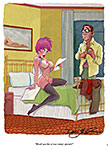
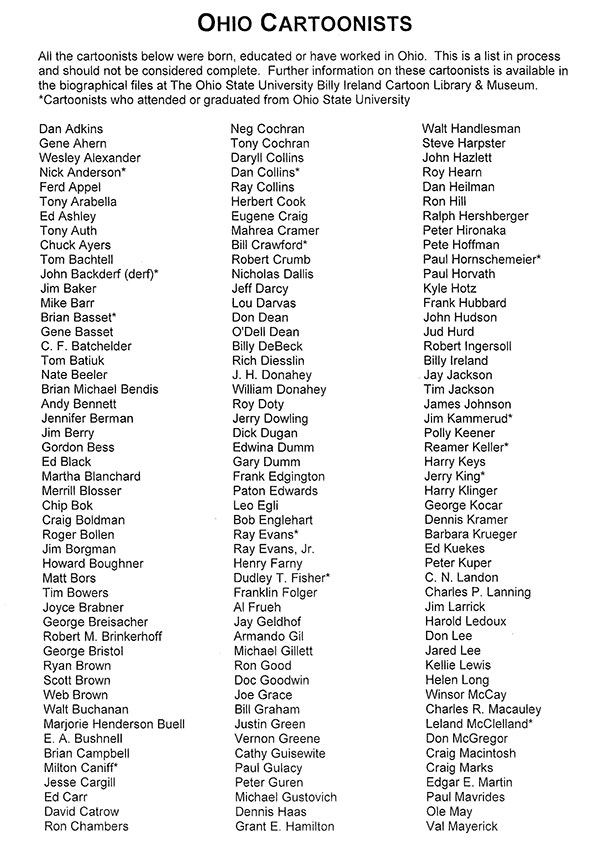
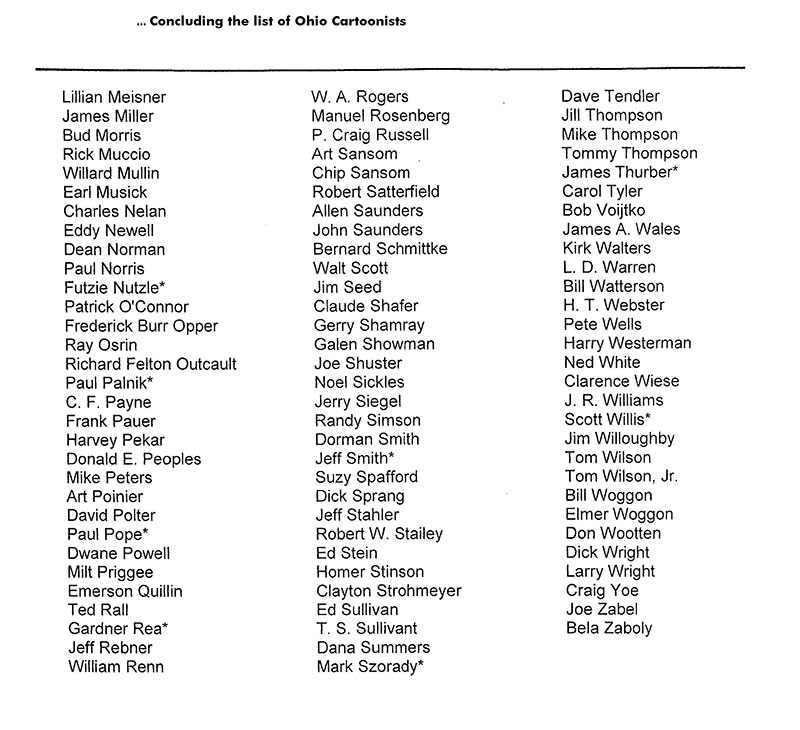


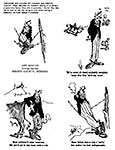
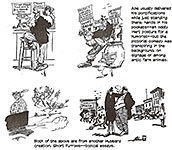
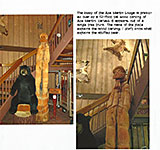
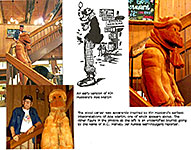
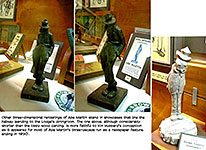
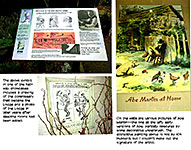
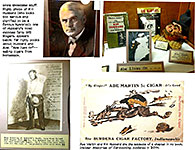
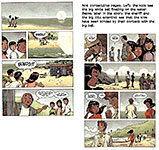


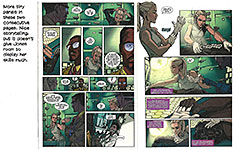
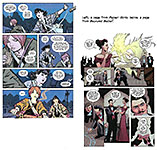
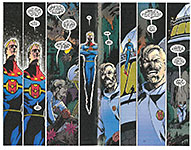
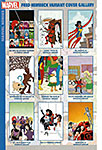
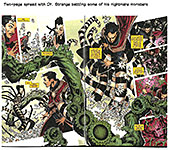
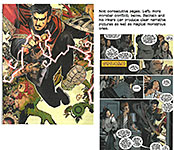
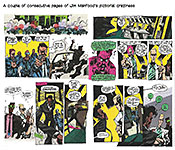
1.jpg)
2.jpg)
3.jpg)
4.jpg)
5.jpg)
6.jpg)


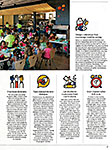
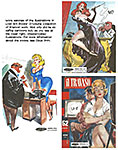
1.jpg)
2.jpg)
3.jpg)
4.jpg)
5.jpg)
6.jpg)
7.jpg)
8.jpg)
9.jpg)
